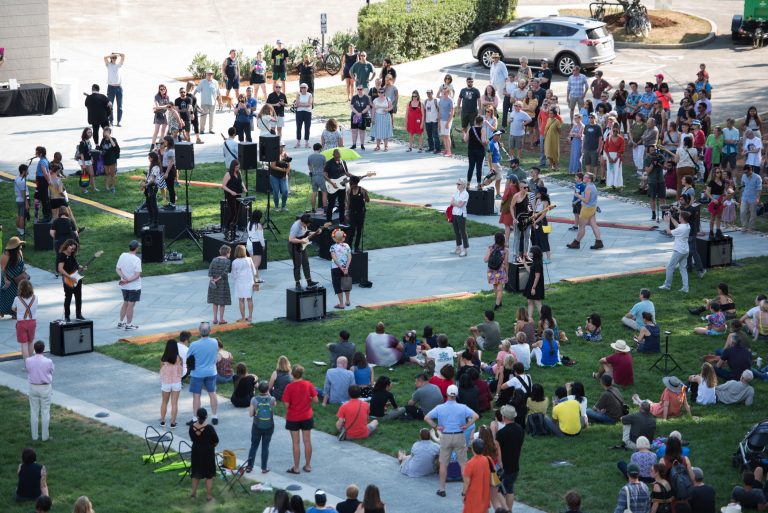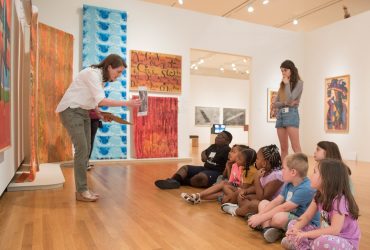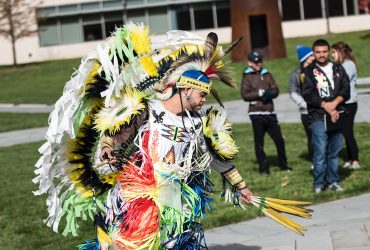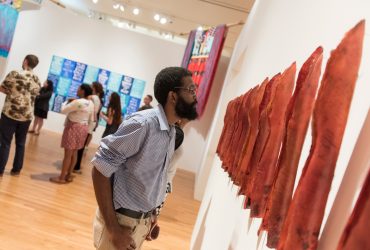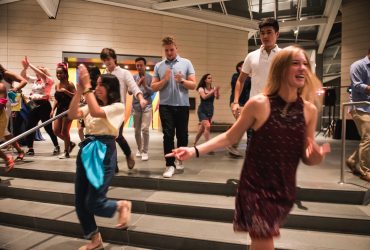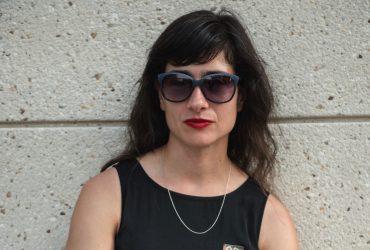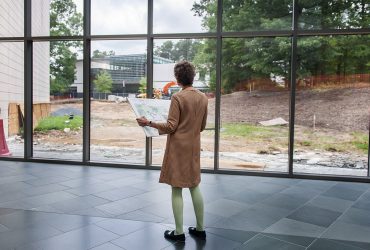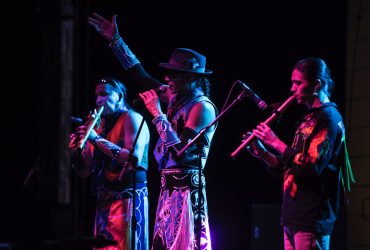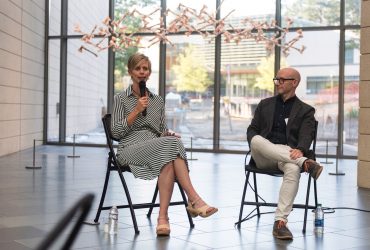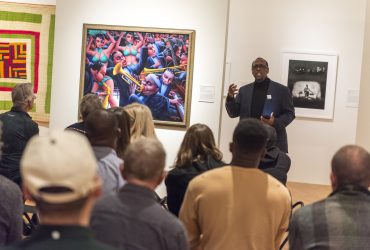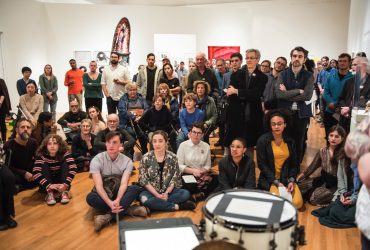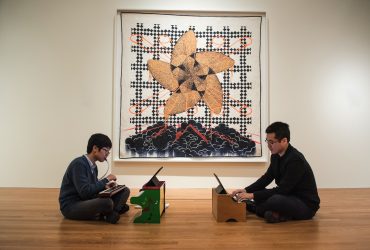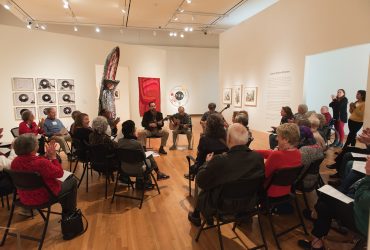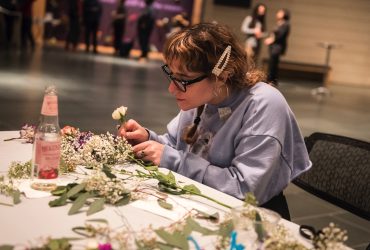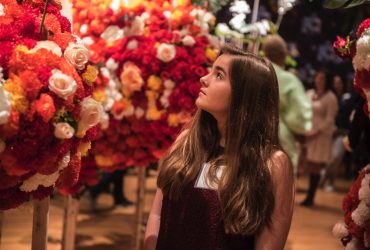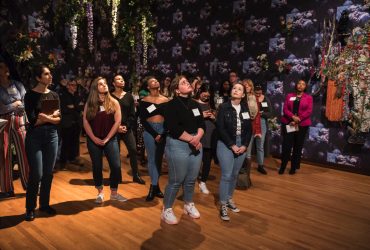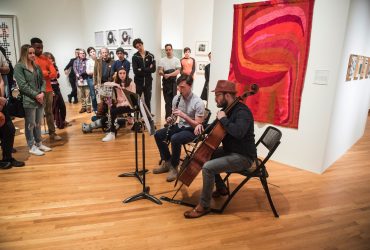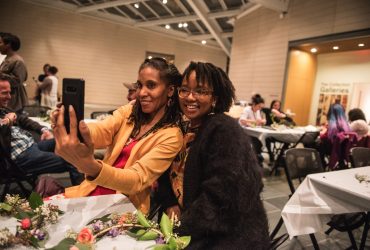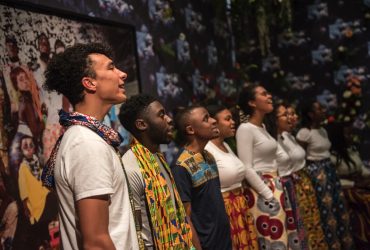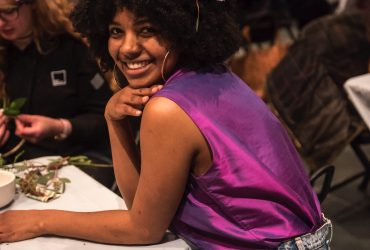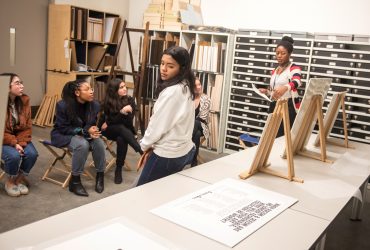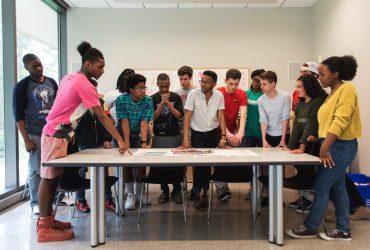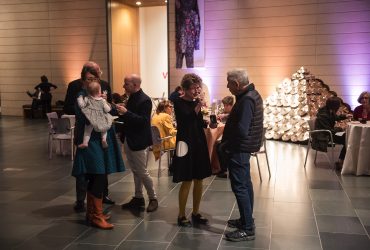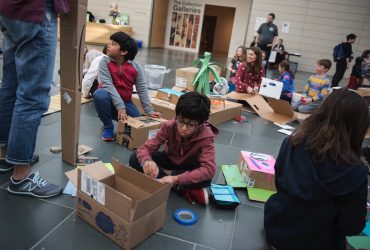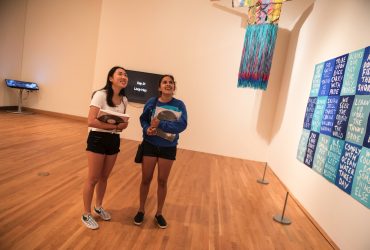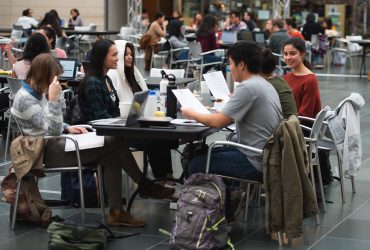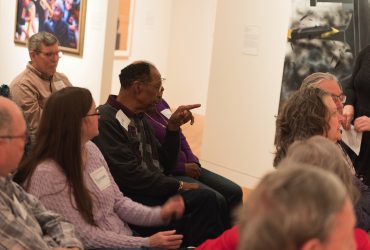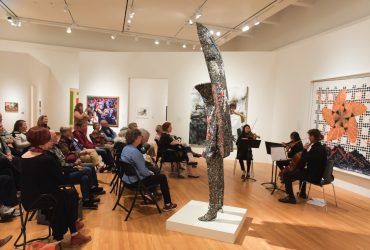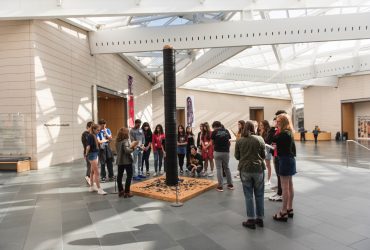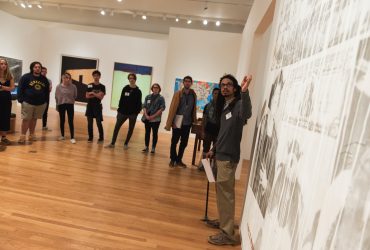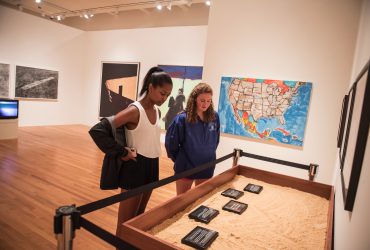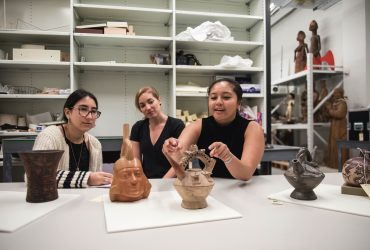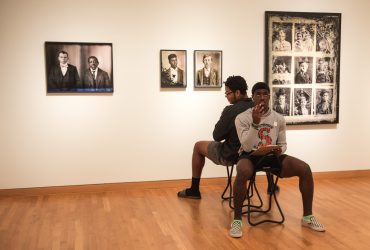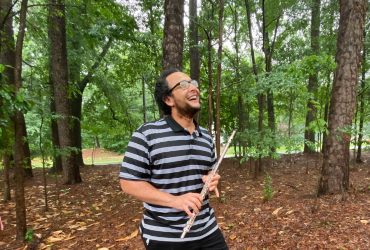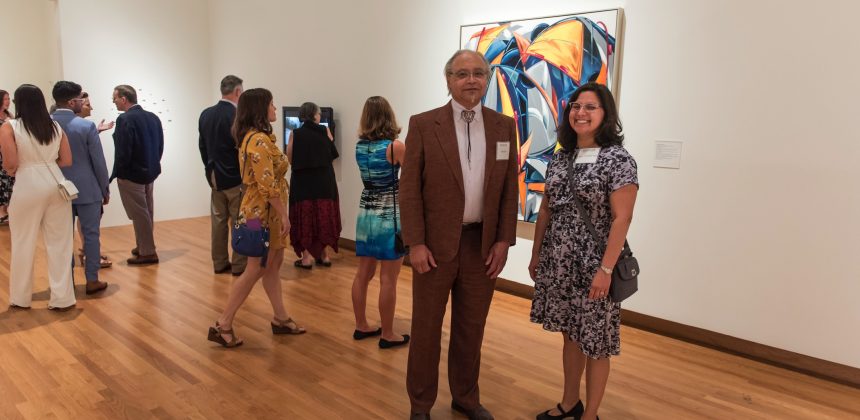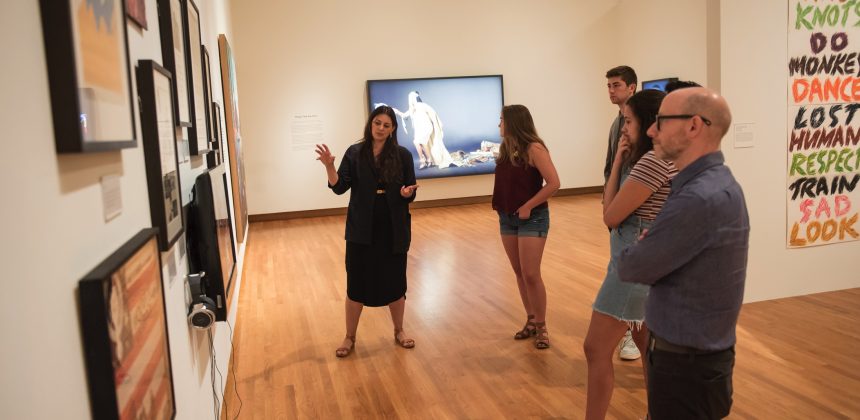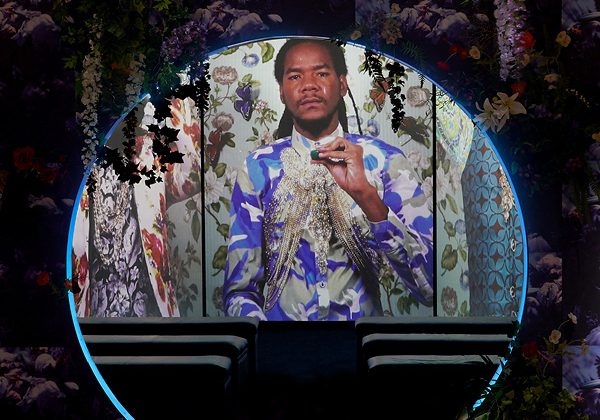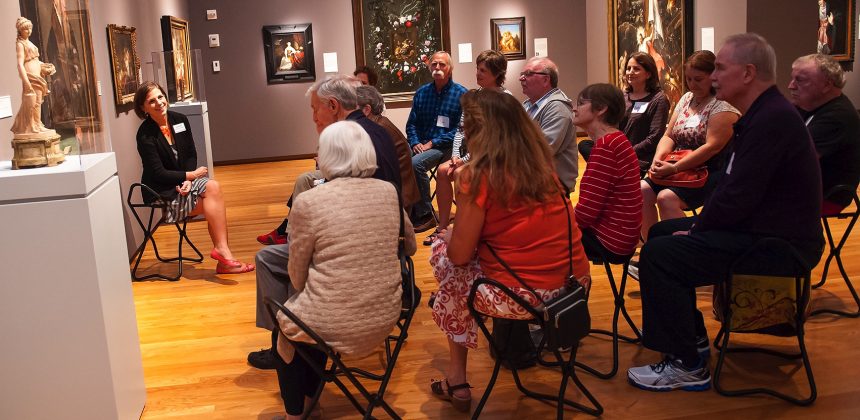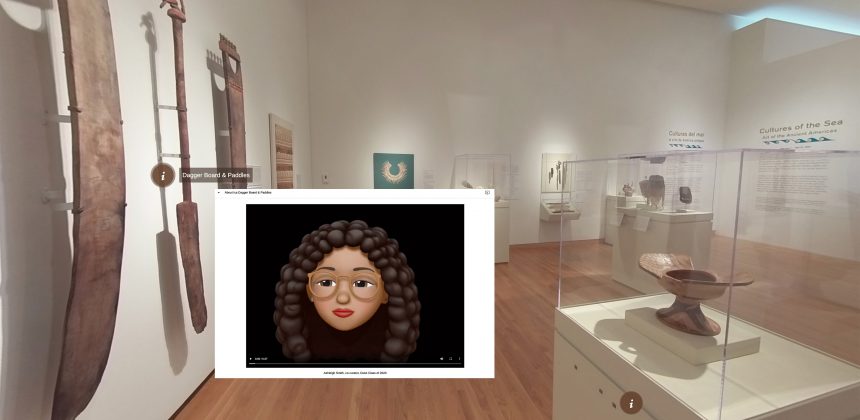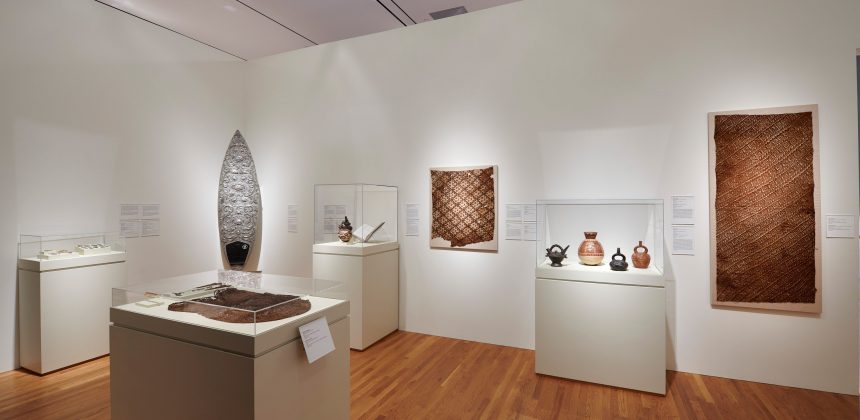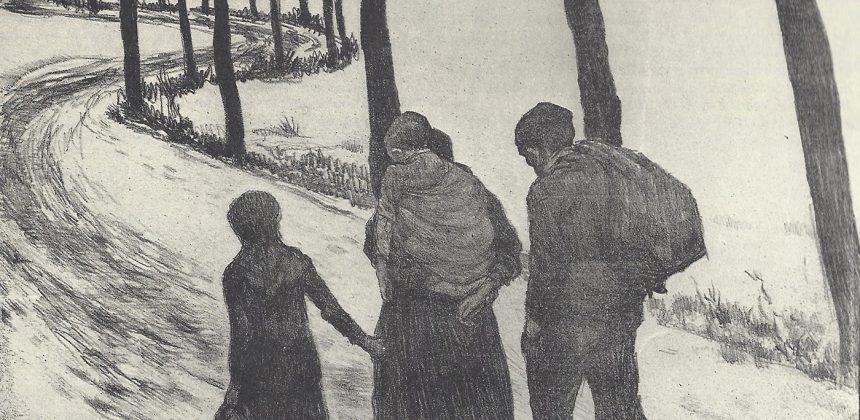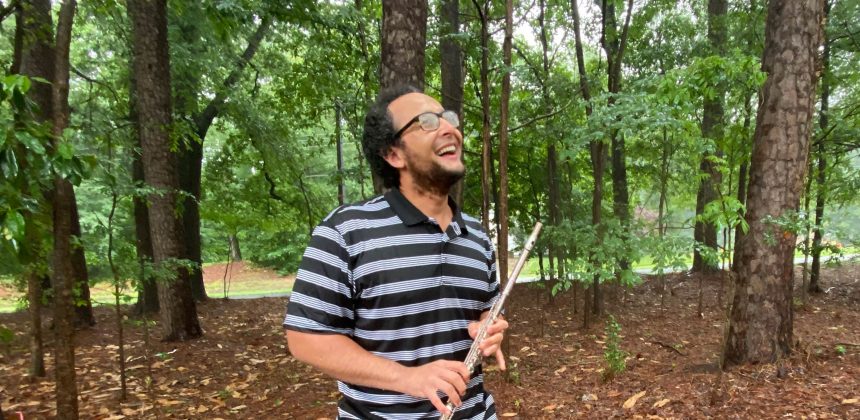PHOTOGRAPHY
Fratelli Alinari
Autel de San Savino dans la cathédrale de Faenza, commandé par Giovanna Manfredi en 1468 à Benedetto da Maiano efferminè entre 1470 et 1479 (Altar of San Savino in the Cathedral of Faenza, commissioned by Giovanna Manfredi in 1468, sculpted by Benedetto da Maiano between 1470 and 1479) , Faenza, Italy, c. 1860s. Vintage albumen print from a collodion negative, 15 1/4 × 12 1/2 inches (38.74 × 31.75 cm). Gift of Charles (A.B.’84) and Linda Googe, 2019.17.126.
Prato cattedrale. La madonna col bambino ges ù e santi [Andrea della Robbia (Prato Cathedral. Madonna and baby Jesus with saints [Andrea della Robbia]) , Prato, Italy, c. 1860s. Vintage albumen print from a collodion negative, 12 1/2 × 17 inches (31.75 × 43.18 cm). Gift of Charles (A.B.’84) and Linda Googe, 2019.17.125.
Dmitri Baltermants
“Toy Salamis”: Cyprus, early 1970s
, n.d. (printed 2003). Gelatin silver print, 11 × 14 inches (27.94 × 35.56
cm). Gift of Charles (A.B.’84) and Linda Googe, 2019.17.7.
A hot summer’s day: children at play in the spray of Moscow’s first
sprinkler-truck, n.d. (printed 2003). Gelatin silver print, 16 × 20 inches (40.64 × 50.8
cm). Gift of Charles (A.B.’84) and Linda Googe, 2019.17.1.
A nation turns its back: Khrushchev’s last stand atop the Lenin
Mausoleum, May 1, 1964, n.d. (printed 2003). Gelatin silver print, 16 × 20 inches (40.64 × 50.8
cm). Gift of Charles (A.B.’84) and Linda Googe, 2019.17.2.
A year before the coup: Salvador Allende with his dogs, Chile, 1972, n.d. (printed 2003). Gelatin silver print, 14 x 11 inches (35.56 x 27.94
cm). Gift of Charles (A.B.’84) and Linda Googe, 2019.17.11.
From a Day of Grief, Kerch, Crimea, January 1942, n.d. (printed 2003). Gelatin silver print, 14 x 11 inches (35.56 x 27.94
cm). Gift of Charles (A.B.’84) and Linda Googe, 2019.17.4.
Man entering house, Aragats mountains, Armenia, n.d. (printed 2003). Gelatin silver print, 14 x 11 inches (35.56 x 27.94
cm). Gift of Charles (A.B.’84) and Linda Googe, 2019.17.8.
Movie night, Vietnam 1955 , n.d. (printed 2003). Gelatin silver print, 11 × 14 inches (27.94 × 35.56
cm). Gift of Charles (A.B.’84) and Linda Googe, 2019.17.5.
Pacific fisherman with his nets, n.d. (printed 2003). Gelatin silver print, 14 x 11 inches (35.56 x 27.94
cm). Gift of Charles (A.B.’84) and Linda Googe, 2019.17.12.
Sculpture with thatched huts, Cuba, n.d. (printed 2003). Gelatin silver print, 14 x 11 inches (35.56 x 27.94
cm). Gift of Charles (A.B.’84) and Linda Googe, 2019.17.6.
Test Pilot Ahmet Khan Sultan, Twice Hero of the Soviet Union, 1961, n.d. (printed 2003). Gelatin silver print, 16 × 20 inches (40.64 × 50.8 cm). Gift of Charles (A.B.’84) and Linda Googe, 2019.17.3.
Under their watchful gazes: Brezhnev and company in a balcony decorated
with the Soviet Seal, n.d. (printed 2003). Gelatin silver print, 11 × 14 inches (27.94 × 35.56 cm). Gift of Charles (A.B.’84) and Linda Googe, 2019.17.10.
Yagodinskaya Geological Complex Expedition, Chukotka, n.d. (printed 2003). Gelatin silver print, 14 x 11 inches (35.56 x 27.94 cm). Gift of Charles (A.B.’84) and Linda Googe, 2019.17.9.
Dawoud Bey
David Hammons, Bliz-aard Ball Sale I, 1983. Archival pigment photograph on Dibond mount, edition 1/6, 33 x 44
inches (83.82 x 111.76 cm). Museum purchase, 2019.20.1.
Ilse Bing
Experimental photomontage, 1942 (printed later). Gelatin silver print, 11 × 14 inches (27.94 × 35.56 cm). Gift of Charles (A.B.’84) and Linda Googe, 2019.17.18.
Moving railway clutches on rails, 1929 (printed later). Gelatin silver print, 9 × 13 1/2 inches (22.86 × 34.29 cm). Gift of Charles (A.B.’84) and Linda Googe, 2019.17.15.
Restaurant Au Vieux Paris, 1934 (printed later). Gelatin silver print, 7 1/2 × 9 1/2 inches (19.05 × 24.13 cm). Gift of Charles (A.B.’84) and Linda Googe, 2019.17.16.
Seated man with hat and cane, Frankfurt, 1929 (printed later). Gelatin silver print, 10 × 8 inches (25.4 × 20.32 cm). Gift of Charles (A.B.’84) and Linda Googe, 2019.17.17.
Spider Lily, 1953 (printed later). Gelatin silver print, 13 1/4 × 10 1/4 inches (33.66 × 26.04 cm). Gift of Charles (A.B.’84) and Linda Googe, 2019.17.13.
Two seagulls flying overhead, New York Harbor, 1936. Gelatin silver print, 7 5/8 × 11 1/8 inches (19.37 × 28.26 cm). Gift of Charles (A.B.’84) and Linda Googe, 2019.17.19.
Wild Anemones, 1928 (printed later). Gelatin silver print, 4 1/4 × 3 1/4 inches (10.8 × 8.26 cm). Gift of Charles (A.B.’84) and Linda Googe, 2019.17.14.
Pierre Boucher
King Farouk’s wedding: The enormous crowd in front of the Royal Palace, Cairo, Egypt, 1952. Vintage gelatin silver print, 10 1/4 × 9 1/2 inches (26.04 × 24.13 cm). Gift of Charles (A.B.’84) and Linda Googe, 2019.17.204.
Lighthouse, France, 1935. Vintage gelatin silver print, 10 1/2 × 9 1/4 inches (26.67 × 23.5 cm). Gift of Charles (A.B.’84) and Linda Googe, 2019.17.205.
Portrait of man with graying hair, Saint-Tropez, France, 1935. Vintage gelatin silver print, 10 1/4 × 9 3/4 inches (26.04 × 24.77 cm). Gift of Charles (A.B.’84) and Linda Googe, 2019.17.206.
Domenico Bresolin
Église St Mare l’statues de St Mare, de la Vierge et des 12 apotres par Jacobello et Pietro Paolo dalle Masegne 1393. Crois par Jacopo di Marco Bonato 1394 (Church of Saint Mary, statue of Saint Mary, the virgin and 12 apostles by Jacobello and Pietro Paollo from Masegne 1393. Cross by Jacopo of Marco Bonato 1394), Venice, c. 1860s. Vintage albumen print from a
collodion negative, 11 × 13 1/4 inches (27.94 × 33.66 cm). Gift of Charles (A.B.’84) and Linda Googe, 2019.17.118.
Harry Callahan
Camera Movement on Neon Lights at Night, Chicago, 1946 (printed 1980–1981). Dye transfer print, 8 3/4 × 13 3/8 inches (22.23 × 33.97 cm). Gift of Charles (A.B.’84) and Linda Googe, 2019.17.149.
Cape Cod, 1976 (printed 1980–1981). Dye transfer print, 14 × 18 inches (35.56 × 45.72 cm) overall. Gift of Charles (A.B.’84) and Linda Googe, 2019.17.148.
Paul Caponigro
Little River, Redding, Connecticut, c. 1968. Vintage gelatin silver print made from Polaroid Polapan 4×5 film Type 52, 3 1/2 × 4 1/2 inches (8.89 × 11.43 cm). Gift of Charles (A.B.’84) and Linda Googe, 2019.17.191.
Untitled (Black leaf), n.d. Vintage gelatin silver print made from Polaroid Positive/Negative 4×5 film Type 55, 7 3/4 × 6 1/8 inches (19.69 × 15.56 cm). Gift of Charles (A.B.’84) and Linda Googe, 2019.17.189.
Untitled (Garlic in bowl), n.d. Vintage gelatin silver print (enlargement print) made from Polaroid Positive/Negative 4×5 film Type 55, 7 3/4 × 6 1/8 inches (19.69 × 15.56 cm). Gift of Charles (A.B.’84) and Linda Googe, 2019.17.190.
Untitled (Plants and Sunlight through Forest in Background), 1968. Vintage gelatin silver print and contact print made from Polaroid Polapan 4×5 film Type 52, 4 1/2 × 3 1/2 inches (11.43 × 8.89 cm). Gift of Charles (A.B.’84) and Linda Googe, 2019.17.188.
Henri Cartier-Bresson
Carl Jung, Kusnacht, Switzerland, 1959. Vintage gelatin silver print, 9 7/8 × 6 1/2 inches (25.08 × 16.51 cm). Gift of Charles (A.B.’84) and Linda Googe, 2019.17.153.
Chanel designer M. Esparza, France, 1973. Vintage gelatin silver print, 6 5/8 × 10 inches (16.83 × 25.4 cm). Gift of Charles (A.B.’84) and Linda Googe, 2019.17.154.
Jerome Robbins, New York, 1959. Vintage gelatin silver print, 7 3/4 × 11 3/4 inches (19.69 × 29.85 cm). Gift of Charles (A.B.’84) and Linda Googe, 2019.17.156.
Leonard Bernstein, New York, 1960. Vintage gelatin silver print, 7 3/4 × 11 3/4 inches (19.69 × 29.85 cm). Gift of Charles (A.B.’84) and Linda Googe, 2019.17.230.
Robert Rauschenberg in his Manhattan studio, 1968. Vintage gelatin silver print, 7 3/4 × 11 1/2 inches (19.69 × 29.21 cm). Gift of Charles (A.B.’84) and Linda Googe, 2019.17.155.
Mark Citret
Gull Ascending, Hancock Park, Los Angeles, 2003. Gelatin silver print on vellum (Kodak Polyfiber A), 8 1/2 × 11 inches (21.59 × 27.94 cm). Gift of Charles (A.B.’84) and Linda Googe, 2019.17.21.
Mall Parking Lot, 1997. Gelatin silver print on vellum (Kodak Polyfiber A), 8 1/2 × 11 inches (21.59 × 27.94 cm). Gift of Charles (A.B.’84) and Linda Googe, 2019.17.20.
Mesquite #6, Death Valley, 1997. Gelatin silver print on vellum (Kodak Polyfiber A), 8 1/2 × 5 1/2 inches (21.59 × 13.97 cm). Gift of Charles (A.B.’84) and Linda Googe, 2019.17.26.
Pedestrian Ramp, Upper Market Street, 1999. Gelatin silver print on vellum (Kodak Polyfiber A), 11 × 8 1/2 inches (27.94 × 21.59 cm). Gift of Charles (A.B.’84) and Linda Googe, 2019.17.22.
Shopping Cart, Hailey, Idaho, 2006. Gelatin silver print on vellum (Kodak Polyfiber A), 8 1/2 × 5 1/2 inches (21.59 × 13.97 cm). Gift of Charles (A.B.’84) and Linda Googe, 2019.17.25.
Storm Drain, Flagstaff, 2001. Gelatin silver print on vellum (Kodak Polyfiber A), 11 × 8 1/2 inches (27.94 × 21.59 cm). Gift of Charles (A.B.’84) and Linda Googe, 2019.17.24.
Waiting Man #2, Art Institute of Chicago, 2001. Gelatin silver print on vellum (Kodak Polyfiber A), 11 × 8 1/2 inches (27.94 × 21.59 cm). Gift of Charles (A.B.’84) and Linda Googe, 2019.17.23.
Larry Colwell
Nude seated on log (Joan), Carmel Valley, California, 1958. Vintage gelatin silver print, 8 x 10 inches (20.32 x 25.4 cm). Gift of Charles (A.B.’84) and Linda Googe, 2019.17.244.
Standing nude on dock (Jytte Svendson), c. 1980. Vintage gelatin silver print, 10 × 8 inches (25.4 × 20.32 cm). Gift of Charles (A.B.’84) and Linda Googe, 2019.17.245.
Harold Haliday Costain
Crowd in stand under flag, c. 1935. Vintage gelatin silver print, 10 × 8 inches (25.4 × 20.32 cm). Gift of Charles (A.B.’84) and Linda Googe, 2019.17.31.
Drilling a 60-ton rock salt block, Avery Island, Louisiana, 1934. Vintage gelatin silver print, 6 × 4 1/2 inches (15.24 × 11.43 cm). Gift of Charles (A.B.’84) and Linda Googe, 2019.17.29.
Factory interior with boxes of sugar on conveyor belt, Long Island City, c. 1935. Vintage gelatin silver print, 8 × 10 inches (20.32 × 25.4 cm). Gift of Charles (A.B.’84) and Linda Googe, 2019.17.28.
Night view of two fishermen on dock, c. 1935. Vintage ferrotyped gelatin silver print, 14 × 11 inches (35.56 × 27.94 cm). Gift of Charles (A.B.’84) and Linda Googe, 2019.17.37.
Pan American Airways hangar, Miami, c. 1931. Vintage ferrotyped gelatin silver print, 11 × 14 inches (27.94 × 35.56 cm). Gift of Charles (A.B.’84) and Linda Googe, 2019.17.39.
Pilot with man in suit, c. 1935. Vintage ferrotyped gelatin silver print, 11 × 14 inches (27.94 × 35.56 cm). Gift of Charles (A.B.’84) and Linda Googe, 2019.17.38.
Portrait of Tallulah Bankhead, c. 1935. Vintage ferrotyped gelatin silver print, 14 × 11 inches (35.56 × 27.94 cm). Gift of Charles (A.B.’84) and Linda Googe, 2019.17.32.
Salt distillery, Long Island City, c. 1935. Vintage gelatin silver print, 14 × 11 inches (35.56 × 27.94 cm). Gift of Charles (A.B.’84) and Linda Googe, 2019.17.27.
Stack of clay pots next to tree, Schlegle Orchids, Brooklyn, NY, 1933. Vintage ferrotyped gelatin silver print, 14 × 11 inches (35.56 × 27.94 cm). Gift of Charles (A.B.’84) and Linda Googe, 2019.17.30.
Still life with spools of thread and metal wire, c. 1935. Vintage ferrotyped gelatin silver print, 12 1/2 × 11 inches (31.75 × 27.94 cm). Gift of Charles (A.B.’84) and Linda Googe, 2019.17.35.
Study of Chevrolet grill, c. 1935. Vintage gelatin silver print, 8 × 10 inches (20.32 × 25.4 cm). Gift of Charles (A.B.’84) and Linda Googe, 2019.17.33.
Two models standing in front of car, c. 1935. Vintage gelatin silver print, 11 x 14 inches (27.94 x 35.56 cm). Gift of Charles (A.B.’84) and Linda Googe, 2019.17.34.
Woman painting mannequin face, c. 1935. Vintage gelatin silver print, 10 × 8 inches (25.4 × 20.32 cm). Gift of Charles (A.B.’84) and Linda Googe, 2019.17.36.
Gordon H. Coster
Advertisement: Woman Touching Movable Radio Set, c. 1930. Vintage gelatin silver print, 14 × 11 inches (35.56 × 27.94 cm). Gift of Charles (A.B.’84) and Linda Googe, 2019.17.193.
Fashion photograph: Ladies and Gentleman in Winter Evening Attire, c. 1930s. Vintage gelatin silver print, 16 × 13 1/4 inches (40.64 × 33.66 cm). Gift of Charles (A.B.’84) and Linda Googe, 2019.17.192.
Bruce Davidson
Brooklyn Gang, 1959. Gelatin silver print, 8 × 10 inches (20.3 × 25.4 cm). Anonymous gift, 2018.24.103.
Brooklyn Gang, 1959. Gelatin silver print, 11 × 14 inches (27.9 × 35.6 cm). Anonymous gift, 2018.24.12.
Brooklyn Gang, 1959. Gelatin silver print, 11 × 14 inches (27.9 × 35.6 cm). Anonymous gift, 2018.24.127.
Brooklyn Gang, 1959. Gelatin silver print, 11 × 14 inches (27.9 × 35.6 cm). Anonymous gift, 2018.24.128.
Brooklyn Gang, 1959. Gelatin silver print, 11 × 14 inches (27.9 × 35.6 cm). Anonymous gift, 2018.24.129.
Brooklyn Gang, 1959. Gelatin silver print, 14 x 11 inches (35.6 x 27.9 cm). Anonymous gift, 2018.24.31.
Brooklyn Gang, 1959. Gelatin silver print, 14 × 17 inches (35.6 × 43.2 cm). Anonymous gift, 2018.24.92.
Brooklyn Gang, 1959. Gelatin silver print, 20 x 16 inches (50.8 x 40.6 cm). Anonymous gift, 2018.24.93.
Brooklyn Gang, 1959. Gelatin silver print, 20 × 24 inches (50.8 × 61 cm). Anonymous gift, 2018.24.99.
Brooklyn Gang, 1959. Gelatin silver print, 20 × 24 inches (50.8 × 61 cm). Anonymous gift, 2018.24.102.
Brooklyn Gang, n.d. Gelatin silver print, 24 x 20 inches (61 x 50.8 cm). Anonymous gift, 2018.24.100.
Brooklyn Gang, n.d. Gelatin silver print, 24 x 20 inches (61 x 50.8 cm). Anonymous gift, 2018.24.101.
California – Campers – Trip West – Ugly Americans, 1966. Gelatin silver print, 16 × 20 inches (40.6 × 50.8 cm). Anonymous gift, 2018.24.91.
California – Pacific Coast Highway, 1966. Gelatin silver print, 11 × 14 inches (27.9 × 35.6 cm). Anonymous gift, 2018.24.130.
Central Park – Man, Gapstow Bridge, n.d. Iris print, 21 × 41 inches (53.34 × 104.14 cm). Anonymous gift, 2018.24.132.
Central Park – Man, Gapstow Bridge, n.d. Iris print, 21 × 41 inches (53.34 × 104.14 cm). Anonymous gift, 2018.24.133.
Central Park, 1992. Gelatin silver print, 16 × 20 inches (40.6 × 50.8 cm). Anonymous gift, 2018.24.89.
Central Park – Snow, n.d. Iris print, 21 × 41 inches (53.34 × 104.14 cm). Anonymous gift, 2018.24.131.
Chicago, 1963. Gelatin silver print, 11 × 14 inches (27.9 × 35.6 cm). Anonymous gift, 2018.24.84.
Chicago, 1989. Chromogenic print, 8 × 10 inches (20.3 × 25.4 cm). Anonymous gift, 2018.24.79.
Chicago, 1989. Chromogenic print, 8 × 10 inches (20.3 × 25.4 cm). Anonymous gift, 2018.24.80.
Chicago, n.d. Gelatin silver print, 16 × 20 inches (40.6 × 50.8 cm). Anonymous gift, 2018.24.15.
Circus, 1958. Gelatin silver print, 11 × 14 inches (27.9 × 35.6 cm). Anonymous gift, 2018.24.40.
Circus, 1958. Gelatin silver print, 11 × 14 inches (27.9 × 35.6 cm). Anonymous gift, 2018.24.41.
Circus, 1958. Gelatin silver print, 11 × 14 inches (27.9 × 35.6 cm). Anonymous gift, 2018.24.42.
Circus, 1958. Gelatin silver print, 11 × 14 inches (27.9 × 35.6 cm). Anonymous gift, 2018.24.44.
Circus, 1958. Gelatin silver print, 14 x 11 inches (35.6 x 27.9 cm). Anonymous gift, 2018.24.39.
Circus, 1958. Gelatin silver print, 14 x 11 inches (35.6 x 27.9 cm). Anonymous gift, 2018.24.43.
Circus, 1958 (printed later). Gelatin silver print, 11 × 14 inches (27.9 × 35.6 cm). Anonymous gift, 2018.24.3.
Circus, 1958 (printed later). Gelatin silver print, 14 x 11 inches (35.6 x 27.9 cm). Anonymous gift, 2018.24.2.
Circus, 1958 (printed later). Gelatin silver print, 14 x 11 inches (35.6 x 27.9 cm). Anonymous gift, 2018.24.4.
Circus, 1958 (printed later). Gelatin silver print, 14 x 11 inches (35.6 x 27.9 cm). Anonymous gift, 2018.24.5.
Circus, 1958 (printed later). Gelatin silver print, 14 x 11 inches (35.6 x 27.9 cm). Anonymous gift, 2018.24.6.
Circus, 1958 (printed later). Gelatin silver print, 14 x 11 inches (35.6 x 27.9 cm). Anonymous gift, 2018.24.7.
Circus, 1958 (printed later). Gelatin silver print, 14 x 11 inches (35.6 x 27.9 cm). Anonymous gift, 2018.24.8.
Circus, 1958 (printed later). Gelatin silver print, 14 x 11 inches (35.6 x 27.9 cm). Anonymous gift, 2018.24.9.
Circus, n.d. Gelatin silver print, 16 × 20 inches (40.6 × 50.8 cm). Anonymous gift, 2018.24.14.
East 100th Street, 1966. Gelatin silver print, 11 × 14 inches (27.9 × 35.6 cm). Anonymous gift, 2018.24.25.
East 100th Street, 1966. Gelatin silver print, 11 × 14 inches (27.9 × 35.6 cm). Anonymous gift, 2018.24.26.
East 100th Street, 1966. Gelatin silver print, 11 × 14 inches (27.9 × 35.6 cm). Anonymous gift, 2018.24.27.
East 100th Street, 1966. Gelatin silver print, 11 × 14 inches (27.9 × 35.6 cm). Anonymous gift, 2018.24.30.
East 100th Street, 1966. Gelatin silver print, 11 × 14 inches (27.9 × 35.6 cm). Anonymous gift, 2018.24.45.
East 100th Street, 1966. Gelatin silver print, 11 × 14 inches (27.9 × 35.6 cm). Anonymous gift, 2018.24.47.
East 100th Street, 1966. Gelatin silver print, 11 × 14 inches (27.9 × 35.6 cm). Anonymous gift, 2018.24.48.
East 100th Street, 1966. Gelatin silver print, 11 × 14 inches (27.9 × 35.6 cm). Anonymous gift, 2018.24.50.
East 100th Street, 1966. Gelatin silver print, 11 × 14 inches (27.9 × 35.6 cm). Anonymous gift, 2018.24.51.
East 100th Street, 1966. Gelatin silver print, 11 × 14 inches (27.9 × 35.6 cm). Anonymous gift, 2018.24.52.
East 100th Street, 1966. Gelatin silver print, 11 × 14 inches (27.9 × 35.6 cm). Anonymous gift, 2018.24.53.
East 100th Street, 1966. Gelatin silver print, 11 × 14 inches (27.9 × 35.6 cm). Anonymous gift, 2018.24.95.
East 100th Street, 1966. Gelatin silver print, 11 × 14 inches (27.9 × 35.6 cm). Anonymous gift, 2018.24.97.
East 100th Street, 1966. Gelatin silver print, 14 x 11 inches (35.6 x 27.9 cm). Anonymous gift, 2018.24.28.
East 100th Street, 1966. Gelatin silver print, 14 x 11 inches (35.6 x 27.9 cm). Anonymous gift, 2018.24.29.
East 100th Street, 1966. Gelatin silver print, 14 x 11 inches (35.6 x 27.9 cm). Anonymous gift, 2018.24.46.
East 100th Street, 1966. Gelatin silver print, 14 x 11 inches (35.6 x 27.9 cm). Anonymous gift, 2018.24.49.
East 100th Street, 1966. Gelatin silver print, 14 x 11 inches (35.6 x 27.9 cm). Anonymous gift, 2018.24.54.
East 100th Street, 1966. Gelatin silver print, 14 x 11 inches (35.6 x 27.9 cm). Anonymous gift, 2018.24.55.
East 100th Street, 1966. Gelatin silver print, 14 x 11 inches (35.6 x 27.9 cm). Anonymous gift, 2018.24.94.
East 100th Street, 1966. Gelatin silver print, 14 x 11 inches (35.6 x 27.9 cm). Anonymous gift, 2018.24.96.
East 100th Street, 1966. Gelatin silver print, 14 x 11 inches (35.6 x 27.9 cm). Anonymous gift, 2018.24.98.
England & Scotland & Wales, n.d. Gelatin silver print, 11 × 14 inches (27.9 × 35.6 cm). Anonymous gift, 2018.24.13.
Italy – Sicily, 1961. Gelatin silver print, 8 × 10 inches (20.3 × 25.4 cm). Anonymous gift, 2018.24.71.
Italy – Sicily, 1961. Gelatin silver print, 8 × 10 inches (20.3 × 25.4 cm). Anonymous gift, 2018.24.74.
Italy – Sicily, 1961. Gelatin silver print, 8 × 10 inches (20.3 × 25.4 cm). Anonymous gift, 2018.24.76.
Italy – Sicily, 1961. Gelatin silver print, 8 × 10 inches (20.3 × 25.4 cm). Anonymous gift, 2018.24.77.
Italy – Sicily, 1961. Gelatin silver print, 8 × 10 inches (20.3 × 25.4 cm). Anonymous gift, 2018.24.78.
Italy – Sicily, 1961. Gelatin silver print, 10 x 8 inches (25.4 x 20.3 cm). Anonymous gift, 2018.24.72.
Italy – Sicily, 1961. Gelatin silver print, 10 x 8 inches (25.4 x 20.3 cm). Anonymous gift, 2018.24.73.
Italy – Sicily, 1961. Gelatin silver print, 10 x 8 inches (25.4 x 20.3 cm). Anonymous gift, 2018.24.75.
Italy – Sicily, n.d. Gelatin silver print, 8 × 10 inches (20.3 × 25.4 cm). Anonymous gift, 2018.24.70.
Italy – Sicily, n.d. Gelatin silver print, 11 × 14 inches (27.9 × 35.6 cm). Anonymous gift, 2018.24.69.
New York – Lower East Side, 1957. Gelatin silver print, 14 x 11 inches (35.6 x 27.9 cm). Anonymous gift, 2018.24.86.
New York – Lower East Side, 1957. Gelatin silver print, 14 x 11 inches (35.6 x 27.9 cm). Anonymous gift, 2018.24.87.
New York – Lower East Side, 1990. Resin-coated print, 10 x 8 inches (25.4 x 20.3 cm). Anonymous gift, 2018.24.17.
New York – Lower East Side, 1990. Resin-coated print, 8 × 10 inches (20.3 × 25.4 cm). Anonymous gift, 2018.24.18.
New York – Lower East Side, 1990. Resin-coated print, 10 x 8 inches (25.4 x 20.3 cm). Anonymous gift, 2018.24.19.
New York – Lower East Side, 1990. Resin-coated print, 8 × 10 inches (20.3 × 25.4 cm). Anonymous gift, 2018.24.20.
Portraits – Cal Ripkin, 1995. Resin-coated print, 8 × 10 inches (20.3 × 25.4 cm). Anonymous gift, 2018.24.81.
Portraits – Edward Steichen, 1963. Gelatin silver print, 11 × 14 inches (27.9 × 35.6 cm). Anonymous gift, 2018.24.85.
Portraits – Max Cleland, 1999. Resin-coated print, 8 × 10 inches (20.3 × 25.4 cm). Anonymous gift, 2018.24.82.
Portraits – Sammy Davis Jr., 1965. Gelatin silver print, 11 × 14 inches (27.9 × 35.6 cm). Anonymous gift, 2018.24.38.
Portraits – Thomas Hart Benton, 1971. Gelatin silver print, 16 × 20 inches (40.6 × 50.8 cm). Anonymous gift, 2018.24.90.
Portraits – Unidentified, 1965. Gelatin silver print, 14 x 11 inches (35.6 x 27.9 cm). Anonymous gift, 2018.24.83.
Spanish Priest, 1965. Gelatin silver print, 14 x 11 inches (35.6 cm x 27.9 cm). Anonymous gift, 2018.24.36.
Spanish Priest, 1965. Gelatin silver print, 14 x 11 inches (35.6 cm x 27.9 cm). Anonymous gift, 2018.24.37.
Subway, n.d. Chromogenic print, 8 × 10 inches (20.3 × 25.4 cm). Anonymous gift, 2018.24.117.
Subway, n.d. Chromogenic print, 8 × 10 inches (20.3 × 25.4 cm). Anonymous gift, 2018.24.118.
Subway, n.d. Chromogenic print, 8 × 10 inches (20.3 × 25.4 cm). Anonymous gift, 2018.24.119.
Subway, n.d. Chromogenic print, 20 × 24 inches (50.8 × 61 cm). Anonymous gift, 2018.24.124.
Subway – Saint Ann’s (2013), n.d. Dye transfer print, 20 × 24 inches (50.8 × 61 cm). Anonymous, 2018.24.125.
Subway – Saint Ann’s (2013), n.d. Dye transfer print, 20 × 24 inches (50.8 × 61 cm). Anonymous, 2018.24.126.
Time of Change, 1960. Gelatin silver print, 10 x 8 inches (25.4x 20.3 cm). Anonymous gift, 2018.24.106.
Time of Change, 1962. Gelatin silver print, 8 × 10 inches (20.3 × 25.4 cm). Anonymous gift, 2018.24.21.
Time of Change, 1962. Gelatin silver print, 8 × 10 inches (20.3 × 25.4 cm). Anonymous gift, 2018.24.22.
Time of Change, 1962. Gelatin silver print, 8 × 10 inches (20.3 × 25.4 cm). Anonymous gift, 2018.24.56.
Time of Change, 1962. Gelatin silver print, 8 × 10 inches (20.3 × 25.4 cm). Anonymous gift, 2018.24.57.
Time of Change, 1962. Gelatin silver print, 8 × 10 inches (20.3 × 25.4 cm). Anonymous gift, 2018.24.59.
Time of Change, 1962. Gelatin silver print, 8 × 10 inches (20.3 × 25.4 cm). Anonymous gift, 2018.24.60.
Time of Change, 1962. Gelatin silver print, 8 × 10 inches (20.3 × 25.4 cm). Anonymous gift, 2018.24.63.
Time of Change, 1962. Gelatin silver print, 8 × 10 inches (20.3 × 25.4 cm). Anonymous gift, 2018.24.104.
Time of Change, 1962. Gelatin silver print, 8 × 10 inches (20.3 × 25.4 cm). Anonymous gift, 2018.24.105.
Time of Change, 1962. Gelatin silver print, 8 × 10 inches (20.3 × 25.4 cm). Anonymous gift, 2018.24.107.
Time of Change, 1962. Gelatin silver print, 8 × 10 inches (20.3 × 25.4 cm). Anonymous gift, 2018.24.110.
Time of Change, 1962. Gelatin silver print, 8 × 10 inches (20.3 × 25.4 cm). Anonymous gift, 2018.24.113.
Time of Change, 1962. Gelatin silver print, 8 × 10 inches (20.3 × 25.4 cm). Anonymous gift, 2018.24.116.
Time of Change, 1962. Gelatin silver print, 10 x 8 inches (25.4x 20.3 cm). Anonymous gift, 2018.24.58.
Time of Change, 1962. Gelatin silver print, 10 x 8 inches (25.4x 20.3 cm). Anonymous gift, 2018.24.64.
Time of Change, 1962. Gelatin silver print, 10 x 8 inches (25.4x 20.3 cm). Anonymous gift, 2018.24.109.
Time of Change, 1962. Gelatin silver print, 10 x 8 inches (25.4x 20.3 cm). Anonymous gift, 2018.24.114.
Time of Change, 1962. Gelatin silver print, 16 × 20 inches (40.6 × 50.8 cm). Anonymous gift, 2018.24.88.
Time of Change, 1962. Gelatin silver print, 10 x 8 inches (25.4x 20.3 cm). Anonymous gift, 2018.24.111.
Time of Change, 1962. Gelatin silver print, 11 × 14 inches (27.9 × 35.6 cm). Anonymous gift, 2018.24.120.
Time of Change, 1962. Gelatin silver print, 11 × 14 inches (27.9 × 35.6 cm). Anonymous gift, 2018.24.121.
Time of Change, 1962. Gelatin silver print, 14 x 11 inches (35.6 x 27.9 cm). Anonymous gift, 2018.24.122.
Time of Change, 1963. Gelatin silver print, 10 x 8 inches (25.4x 20.3 cm). Anonymous gift, 2018.24.61.
Time of Change, 1963. Gelatin silver print, 10 x 8 inches (25.4x 20.3 cm). Anonymous gift, 2018.24.62.
Time of Change, 1963. Gelatin silver print, 10 x 8 inches (25.4x 20.3 cm). Anonymous gift, 2018.24.108.
Time of Change, 1963. Gelatin silver print, 11 × 14 inches (27.9 × 35.6 cm). Anonymous gift, 2018.24.123.
Time of Change, 1963–1965. Resin-coated print, 8 × 11 inches (20.3 × 27.9 cm). Anonymous gift, 2018.24.16.
Time of Change, 1965. Gelatin silver print, 8 × 10 inches (20.3 × 25.4 cm). Anonymous gift, 2018.24.68.
Time of Change, 1965. Gelatin silver print, 10 x 8 inches (25.4x 20.3 cm). Anonymous gift, 2018.24.65.
Time of Change, 1965. Gelatin silver print, 10 x 8 inches (25.4x 20.3 cm). Anonymous gift, 2018.24.66.
Time of Change, 1965. Gelatin silver print, 10 x 8 inches (25.4x 20.3 cm). Anonymous gift, 2018.24.67.
Time of Change, 1965. Gelatin silver print, 10 x 8 inches (25.4x 20.3 cm). Anonymous gift, 2018.24.112.
Time of Change, 1965. Gelatin silver print, 10 x 8 inches (25.4x 20.3 cm). Anonymous gift, 2018.24.115.
Time of Change, 1970–1980. Gelatin silver print, 14 x 11 inches (35.6 x 27.9 cm). Anonymous gift, 2018.24.1.
Time of Change, n.d. Gelatin silver print, 8 × 10 inches (20.3 × 25.4 cm). Anonymous gift, 2018.24.23.
Time of Change, n.d. Gelatin silver print, 10 x 8 inches (25.4 x 20.3 cm). Anonymous gift, 2018.24.24.
Topless Restaurant, 1965. Gelatin silver print, 14 x 11 inches (35.6 x 27.9 cm). Anonymous gift, 2018.24.32.
Topless Restaurant, 1965. Gelatin silver print, 14 x 11 inches (35.6 x 27.9 cm). Anonymous gift, 2018.24.33.
Topless Restaurant, 1965. Gelatin silver print, 14 x 11 inches (35.6 x 27.9 cm). Anonymous gift, 2018.24.34.
Topless Restaurant, 1965. Gelatin silver print, 11 × 14 inches (27.9 × 35.6 cm). Anonymous gift, 2018.24.35.
Widow of Montmartre, 1957–1960. Gelatin silver print, 11 × 14 inches (27.9 × 35.6 cm). Anonymous gift, 2018.24.10.
Widow of Montmartre, 1957–1960. Gelatin silver print, 11 × 14 inches (27.9 × 35.6 cm). Anonymous gift, 2018.24.11.
Mike Disfarmer
Girl standing on table, striped background, c. 1940. Vintage gelatin silver contact print, 4 1/2 × 3 inches (11.43 × 7.62 cm). Gift of Charles (A.B.’84) and Linda Googe, 2019.17.44.
Seated woman in elegant dress, shell background, c. 1920. Vintage gelatin silver contact print, 5 × 3 inches (12.7 × 7.62 cm). Gift of Charles (A.B.’84) and Linda Googe, 2019.17.41.
Standing soldier, c. 1940. Vintage gelatin silver contact print, 4 1/2 × 3 inches (11.43 × 7.62 cm). Gift of Charles (A.B.’84) and Linda Googe, 2019.17.45.
Standing young woman with button-down dress and bow in hair, c. 1940. Vintage ferrotyped gelatin silver print, 5 × 3 inches (12.7 × 7.62 cm). Gift of Charles (A.B.’84) and Linda Googe, 2019.17.43.
Three women and one girl, all standing, c. 1940. Vintage gelatin silver contact print, 4 1/2 × 3 inches (11.43 × 7.62 cm). Gift of Charles (A.B.’84) and Linda Googe, 2019.17.40.
Two standing young men, one holding cigarette, the other with flared collar, c. 1940. Vintage gelatin silver contact print, 5 × 3 inches (12.7 × 7.62 cm). Gift of Charles (A.B.’84) and Linda Googe, 2019.17.42.
František Drtikol, Le Repos (Rest), n.d. (printed c. 1960). Vintage blue-toned gelatin silver bromide print, 8 1/2 × 11 1/4 inches (21.59 × 28.58 cm). Gift of Charles (A.B.’84) and Linda Googe, 2019.17.246.
Alfred Eisenstaedt
Haile Selassie on porch with men and dogs, Ethiopia, c. 1935. Vintage gelatin silver print, 6 3/4 × 9 1/4 inches (17.15 × 23.5 cm). Gift of Charles (A.B.’84) and Linda Googe, 2019.17.47.
Outdoor market, Addis Ababa, Ethiopia, 1935. Vintage gelatin silver print, 6 × 9 1/4 inches (15.24 × 23.5 cm). Gift of Charles (A.B.’84) and Linda Googe, 2019.17.48.
War under the tropical sun: Small artillery unit in eucalyptus trees, second Italo-Abyssinian War, Ethiopia, 1935. Vintage gelatin silver print, 9 1/4 × 4 1/2 inches (23.5 × 11.43 cm). Gift of Charles (A.B.’84) and Linda Googe, 2019.17.46.
Leonard Freed
A search party scouting the undergrowth in a wooded area along the Chattahoochee River, Atlanta, Georgia, 1980. Vintage gelatin silver print, 10 × 8 inches (25.4 × 20.32 cm). Gift of Charles (A.B.’84) and Linda Googe, 2019.17.51.
A shepherd milks his goatherd for handmade cheese production, Sicily, 1974. Vintage gelatin silver print, 10 × 8 inches (25.4 × 20.32 cm). Gift of Charles (A.B.’84) and Linda Googe, 2019.17.143.
A vast billboard asking residents to help the Task Force, Atlanta, Georgia, 1980. Vintage gelatin silver print, 10 x 8 inches (25.4 x 20.32 cm). Gift of Charles (A.B.’84) and Linda Googe, 2019.17.50.
Anthony Sistrunck, wanted for bank robbery and the killing of a policeman, was finally captured. It was then discovered that he was accused of four other murders in four different states. A detective adjusts his handcuffs upon his arrival at the Manhattan homicide squad, NYC, 1975. Vintage gelatin silver print, 10 × 8 inches (25.4 × 20.32 cm). Gift of Charles (A.B.’84) and Linda Googe, 2019.17.52.
Arab refugee camp near Hebron in occupied West Bank, a U.N. car with a medical man, Israel, 1967. Vintage gelatin silver print, 8 × 10 inches (20.32 × 25.4 cm). Gift of Charles (A.B.’84) and Linda Googe, 2019.17.207.
Arab woman in the yard of her home in the Old City of Jerusalem, Israel, 1967. Vintage gelatin silver print, 14 1/4 × 9 3/4 inches (36.2 × 24.77 cm). Gift of Charles (A.B.’84) and Linda Googe, 2019.17.209.
Arabs singing and dancing at a wedding in an Arab village, Israel, 1968. Vintage gelatin silver print, 8 × 10 inches (20.32 × 25.4 cm). Gift of Charles (A.B.’84) and Linda Googe, 2019.17.208.
At all times the detectives carry their guns, even while working at their desks in the police station, NYC, 1975. Vintage gelatin silver print, 10 × 8 inches (25.4 × 20.32 cm). Gift of Charles (A.B.’84) and Linda Googe, 2019.17.54.
Cafe, Venice, Italy, 2004. Vintage gelatin silver print, 8 × 10 inches (20.32 × 25.4 cm). Gift of Charles (A.B.’84) and Linda Googe, 2019.17.133.
Crowd at divorce demonstration, Rome, Italy, 1974. Vintage gelatin silver print, 10 × 8 inches (25.4 × 20.32 cm). Gift of Charles (A.B.’84) and Linda Googe, 2019.17.131.
Goat herder with tools in hand, Sicily, 1974. Vintage gelatin silver print, 10 × 8 inches (25.4 × 20.32 cm). Gift of Charles (A.B.’84) and Linda Googe, 2019.17.141.
Group of nuns, Rome, Italy, 2003. Vintage gelatin silver print, 8 x 10 inches (20.32 x 25.4 cm). Gift of Charles (A.B.’84) and Linda Googe, 2019.17.137.
Horse in car, Rome, Italy, 2001. Vintage gelatin silver print, 8 × 10 inches (20.32 × 25.4 cm). Gift of Charles (A.B.’84) and Linda Googe, 2019.17.139.
Leone Giovanni voting, 1974. Vintage gelatin silver print, 10 × 8 inches (25.4 × 20.32 cm). Gift of Charles (A.B.’84) and Linda Googe, 2019.17.132.
Man in doorway with Christy Turlington billboard, Rome, Italy, 2003. Vintage gelatin silver print, 10 × 8 inches (25.4 × 20.32 cm). Gift of Charles (A.B.’84) and Linda Googe, 2019.17.138.
Man looking for clams in waterbed, Trapani, Sicily, 1975. Vintage gelatin silver print, 8 × 10 inches (20.32 × 25.4 cm). Gift of Charles (A.B.’84) and Linda Googe, 2019.17.145.
Man walking by wooden fisherman, Normandy, France, 1964. Vintage gelatin silver print, 10 × 8 inches (25.4 × 20.32 cm). Gift of Charles (A.B.’84) and Linda Googe, 2019.17.49.
Men with planks, Venice, Italy, 2004. Vintage gelatin silver print, 8 × 10 inches (20.32 × 25.4 cm). Gift of Charles (A.B.’84) and Linda Googe, 2019.17.134.
Men with torches at divorce protest, Rome, Italy, 1974. Vintage gelatin silver print, 8 × 10 inches (20.32 × 25.4 cm). Gift of Charles (A.B.’84) and Linda Googe, 2019.17.129.
Old woman in car holding flag, Rome, Italy, 2001. Vintage gelatin silver print, 8 × 10 inches (20.32 × 25.4 cm). Gift of Charles (A.B.’84) and Linda Googe, 2019.17.136.
Portrait of an elderly man, Sicily, 1974. Vintage gelatin silver print, 8 × 10 inches (20.32 × 25.4 cm). Gift of Charles (A.B.’84) and Linda Googe, 2019.17.142.
Repairing tuna fishing boat, Trapani, Sicily, 1974. Vintage gelatin silver print, 8 × 10 inches (20.32 × 25.4 cm). Gift of Charles (A.B.’84) and Linda Googe, 2019.17.147.
Rows of seated inmates at Tombs Prison, NYC, 1972. Vintage gelatin silver print, 8 × 10 inches (20.32 × 25.4 cm). Gift of Charles (A.B.’84) and Linda Googe, 2019.17.53.
The half-naked body of this victim was found in a cleaning of the woods near the Hudson River and the George Washington Bridge, the homicide squad had to first find her identity and then locate the murderer, NYC, 1975. Vintage gelatin silver print, 8 × 10 inches (20.32 × 25.4 cm). Gift of Charles (A.B.’84) and Linda Googe, 2019.17.55.
The Israeli census people are coming into the Arab homes in the Old City of Jerusalem to count the population after the Six Day War, Israel, 1967. Vintage gelatin silver print, 14 1/2 × 10 inches (36.83 × 25.4 cm). Gift of Charles (A.B.’84) and Linda Googe, 2019.17.210.
The shepherds take turns sleeping nights in the barn to protect their goats and cheese-making tools from being stolen, Sicily, 1974. Vintage gelatin silver print, 10 × 8 inches (25.4 × 20.32 cm). Gift of Charles (A.B.’84) and Linda Googe, 2019.17.144.
The socialist party in the streets of Rome, Italy, 1974. Vintage gelatin silver print, 8 × 10 inches (20.32 × 25.4 cm). Gift of Charles (A.B.’84) and Linda Googe, 2019.17.130.
Tuna fishing boat repair port in old fort, Trapani, Sicily, 1974. Vintage gelatin silver print, 8 × 10 inches (20.32 × 25.4 cm). Gift of Charles (A.B.’84) and Linda Googe, 2019.17.146.
Two nudes, New York, 2002. Vintage gelatin silver print, 10 × 8 inches (25.4 × 20.32 cm). Gift of Charles (A.B.’84) and Linda Googe, 2019.17.247.
Walking down alley, Venice, Italy, 2004. Vintage gelatin silver print, 10 x 8 inches (25.4 x 20.32 cm). Gift of Charles (A.B.’84) and Linda Googe, 2019.17.135.
Woman in apron, Sicily, 1973. Vintage gelatin silver print, 10 × 8 inches (25.4 × 20.32 cm). Gift of Charles (A.B.’84) and Linda Googe, 2019.17.140.
Women in fruit canning factory, Bologna, Italy, 1974. Vintage gelatin silver print, 8 × 10 inches (20.32 × 25.4 cm). Gift of Charles (A.B.’84) and Linda Googe, 2019.17.128.
Gisèle Freund
Jean Paul Sartre and Simone de Beauvoir, année prix Nobel pour Sartre (the year Sartre won the Nobel Prize), 1964. Vintage gelatin silver print, 11 × 7 3/4 inches (27.94 × 19.69 cm). Gift of Charles (A.B.’84) and Linda Googe, 2019.17.157.
Pierre Reverdy, c. 1940. Vintage gelatin silver print, 9 3/4 × 8 inches (24.77 × 20.32 cm). Gift of Charles (A.B.’84) and Linda Googe, 2019.17.158.
Burt Glinn
Brigitte Bardot playing guitar, Saint Tropez, France, 1958. Vintage gelatin silver print, 13 3/4 × 8 7/8 inches (34.93 × 22.54 cm). Gift of Charles (A.B.’84) and Linda Googe, 2019.17.161.
Danny Kaye in Israel with child in wheelchair, 1956. Vintage gelatin silver print, 13 1/2 × 9 inches (34.29 × 22.86 cm). Gift of Charles (A.B.’84) and Linda Googe, 2019.17.162.
Liza Minnelli and her dog during the filming of “Tell Me That You Love Me, Junie Moon,” San Diego, 1969. Vintage gelatin silver print, 9 3/4 × 6 3/4 inches (24.77 × 17.15 cm). Gift of Charles (A.B.’84) and Linda Googe, 2019.17.160.
Portrait of Sammy Davis Jr., 1959. Vintage gelatin silver print, 6 5/8 × 9 5/8 inches (16.83 × 24.45 cm). Gift of Charles (A.B.’84) and Linda Googe, 2019.17.159.
Twiggy with Justin De Villeneuve, London, 1966. Vintage gelatin silver print, 9 3/4 × 6 1/2 inches (24.77 × 16.51 cm). Gift of Charles (A.B.’84) and Linda Googe, 2019.17.163.
David Hartt
Lounge at The Johnson Publishing Company Headquarters, Chicago, Illinois, 2011. Archival pigment print mounted on Dibond, 48 × 64 inches (121.92 × 162.56 cm). Museum purchase with funds provided by Doug Smooke (A.B.’90) and Kim Blackwell (A.B.’89, H.S.’94–’00), 2020.2.1.
Ken Heyman
A Northern chieftain watches the ceremony in Sokato on Independence Day in Northern Region, Nigeria, 1959. Vintage gelatin silver print, 13 × 9 1/4 inches (33.02 × 23.5 cm). Gift of Charles (A.B.’84) and Linda Googe, 2019.17.64.
A poor village woman of Kenya looking for lice in her baby’s hair. She carries her baby but usually on her side and swings the infant in front of her for breastfeeding, Kenya, 1965. Vintage gelatin silver print, 12 × 9 inches (30.48 × 22.86 cm). Gift of Charles (A.B.’84) and Linda Googe, 2019.17.60.
A typical village scene, Meshia, twenty-five miles from Cairo, Egypt, n.d. (printed later). Gelatin silver print, 11 × 14 inches (27.94 × 35.56 cm). Gift of Charles (A.B.’84) and Linda Googe, 2019.17.62.
Amputated child behind wood panel, Nigeria, 1961. Vintage gelatin silver print, 14 × 11 1/2 inches (35.56 × 29.21 cm). Gift of Charles (A.B.’84) and Linda Googe, 2019.17.57.
An engineman and an old locomotive, Knoxville, Tennessee, 1963 (printed later). Gelatin silver print, 11 × 14 inches (27.94 × 35.56 cm). Gift of Charles (A.B.’84) and Linda Googe, 2019.17.61.
Boys and women in sampans, Hong Kong, c. 1968. Vintage gelatin silver print, 11 × 14 inches (27.94 × 35.56 cm). Gift of Charles (A.B.’84) and Linda Googe, 2019.17.63.
Claes Oldenburg, Allen Jones, Roy Lichtenstein, British fashion model Jean Shrimpton and Andy Warhol, 1964 (printed later). Gelatin silver print, 16 × 20 inches (40.64 × 50.8 cm). Gift of Charles (A.B.’84) and Linda Googe, 2019.17.164.
During Semana Santa, or Holy Week at Easter time in Seville, Spain. These men are resting after carrying huge float in the religious precession, 1964. Vintage gelatin silver print, 12 1/2 × 16 1/2 inches (31.75 × 41.91 cm). Gift of Charles (A.B.’84) and Linda Googe, 2019.17.56.
Grandparents and granddaughters enjoy each other’s company in the yard, Sicily, c. 1960. Vintage gelatin silver print, 11 × 17 inches (27.94 × 43.18 cm). Gift of Charles (A.B.’84) and Linda Googe, 2019.17.58.
India, the Ganges, 1974. Gelatin silver print, 7 3/8 × 9 7/8 inches (18.73 × 25.08 cm). Gift of Charles (A.B.’84) and Linda Googe, 2019.17.59.
Ken and daughter’s toosh, Florida, 1972. Vintage gelatin silver print, 12 1/2 × 13 1/2 inches (31.75 × 34.29 cm). Gift of Charles (A.B.’84) and Linda Googe, 2019.17.248.
Leonard Bernstein, New York, n.d. (printed later) Gelatin silver print, 16 × 20 inches (40.64 × 50.8 cm). Gift of Charles (A.B.’84) and Linda Googe, 2019.17.231.
Roy Lichtenstein in mirror reflections, 1964 (printed later). Gelatin silver print, 16 × 20 inches (40.64 × 50.8 cm). Gift of Charles (A.B.’84) and Linda Googe, 2019.17.165.
Florence Homolka
Charles Laughton and Eugenie Leontovitch performing Chekhov’s The Cherry Orchard, c. 1960. Vintage gelatin silver print, 13 1/2 × 10 1/2 inches (34.29 × 26.67 cm). Gift of Charles (A.B.’84) and Linda Googe, 2019.17.167.
Charlie Chaplin in pajamas with tall hat on the set of Limelight, 1952. Vintage gelatin silver print, 20 x 16 inches (50.8 x 40.64 cm). Gift of Charles (A.B.’84) and Linda Googe, 2019.17.166.
Maurice Utrillo, c. 1960. Vintage gelatin silver print, 14 × 11 inches (35.56 × 27.94 cm). Gift of Charles (A.B.’84) and Linda Googe, 2019.17.168.
Henry Horenstein
Bartenders, Cajun Bar, New Orleans, LA from the series Honky Tonk, 1972. Vintage gelatin silver print, 10 × 8 inches (25.4 × 20.32 cm). Gift of Charles (A.B.’84) and Linda Googe, 2019.17.68.
Blues Singer, Houston, TX from the series Honky Tonk, 2007. Gelatin silver print, 20 × 16 inches (50.8 × 40.64 cm). Gift of Charles (A.B.’84) and Linda Googe, 2019.17.65.
Clyde Moody from the series Honky Tonk, c. 1973. Vintage gelatin silver print, 8 × 10 inches (20.32 × 25.4 cm). Gift of Charles (A.B.’84) and Linda Googe, 2019.17.69.
Emmy Lou Harris at Home, Los Angeles, CA from the series Honky Tonk, 1980 (printed later). Gelatin silver print, edition 2/25, 20 × 16 inches (50.8 × 40.64 cm). Gift of Charles (A.B.’84) and Linda Googe, 2019.17.66.
Family 2, Lone Star Ranch, Reeds Ferry, New Hampshire from the series Honky Tonk, 1972. Vintage gelatin silver print, 10 × 8 inches (25.4 × 20.32 cm). Gift of Charles (A.B.’84) and Linda Googe, 2019.17.70.
Slow Dancing, Bar on Boardwalk, Hollywood, FL from the series Honky Tonk II, 1994. Gelatin silver print, 16 × 20 inches (40.64 × 50.8 cm). Gift of Charles (A.B.’84) and Linda Googe, 2019.17.67.
Untitled, Boston, Massachusetts from the series Humans, 2003. Sepia-toned gelatin silver print, 20 × 16 inches (50.8 × 40.64 cm). Gift of Charles (A.B.’84) and Linda Googe, 2019.17.251.
Untitled, Boston, Massachusetts from the series Humans, 2003. Sepia-toned gelatin silver print, edition 1/25, 20 × 16 inches (50.8 × 40.64 cm). Gift of Charles (A.B.’84) and Linda Googe, 2019.17.249
Untitled, Boston, Massachusetts from the series Humans, 2003. Vintage gelatin silver print, 20 × 16 inches (50.8 × 40.64 cm). Gift of Charles (A.B.’84) and Linda Googe, 2019.17.250.
André Kertész, Celebration in Montparnasse after the first Futurist ballet, 1954. Vintage gelatin silver print, 7 1/4 x 9 1/2 inches (18.42 x 24.13 cm). Gift of Charles (A.B.’84) and Linda Googe, 2019.17.169.
Jacques Lowe
Construction worker in “Bethlehem Steel” hardhat leaning with toolbox and wrench, c. 1955. Vintage gelatin silver print, 14 × 11 inches (35.56 × 27.94 cm). Gift of Charles (A.B.’84) and Linda Googe, 2019.17.75.
Construction worker walking with tool box, c. 1955. Vintage gelatin silver print, 14 × 11 inches (35.56 × 27.94 cm). Gift of Charles (A.B.’84) and Linda Googe, 2019.17.73.
Construction worker working on heavy pipes, c. 1955. Vintage gelatin silver print, 14 × 11 inches (35.56 × 27.94 cm). Gift of Charles (A.B.’84) and Linda Googe, 2019.17.74.
Construction workers pulling cables on top of skyscraper with smoking industrial chimneys in view, c. 1955. Vintage gelatin silver print, 11 × 14 inches (27.94 × 35.56 cm). Gift of Charles (A.B.’84) and Linda Googe, 2019.17.71.
Double bass, 1955. Vintage gelatin silver print, 10 × 8 inches (25.4 × 20.32 cm). Gift of Charles (A.B.’84) and Linda Googe, 2019.17.233.
Eileen Heckart laughing with hands on hips, c. 1960. Vintage gelatin silver print, 14 × 11 inches (35.56 × 27.94 cm). Gift of Charles (A.B.’84) and Linda Googe, 2019.17.178.
Frances Sternhagen washing dishes while husband plays with infant, 1956. Vintage gelatin silver print, 13 1/4 × 8 3/4 inches (33.66 × 22.23 cm). Gift of Charles (A.B.’84) and Linda Googe, 2019.17.172.
Kim Novak behind flowers, c. 1950s. Vintage gelatin silver print, 14 × 11 inches (35.56 × 27.94 cm). Gift of Charles (A.B.’84) and Linda Googe, 2019.17.173
Marlon Brando on the set of “On the Waterfront” with co-star Eva Marie Saint, 1954. Vintage gelatin silver print, 9 1/2 × 7 1/4 inches (24.13 × 18.42 cm). Gift of Charles (A.B.’84) and Linda Googe, 2019.17.170.
Musician and composer Joseph Kyagambiddwa listening to jazz, 1955. Vintage gelatin silver print, 10 × 8 inches (25.4 × 20.32 cm). Gift of Charles (A.B.’84) and Linda Googe, 2019.17.232.
New York City Park Department – Sculptor chiseling man and hound sculpture, c. 1955. Vintage gelatin silver print, 8 × 10 inches (20.32 × 25.4 cm). Gift of Charles (A.B.’84) and Linda Googe, 2019.17.80.
New York City Park Department – Sign maker nailing a sign, c. 1955. Vintage gelatin silver print, 8 × 10 inches (20.32 × 25.4 cm). Gift of Charles (A.B.’84) and Linda Googe, 2019.17.77.
New York City Park Department – Sign makers, c. 1955. Vintage gelatin silver print, 10 × 8 inches (25.4 × 20.32 cm). Gift of Charles (A.B.’84) and Linda Googe, 2019.17.76.
New York City Park Department – Worker doing metal work, c. 1955. Vintage gelatin silver print, 10 x 8 inches (25.4 x 20.32 cm). Gift of Charles (A.B.’84) and Linda Googe, 2019.17.78.
New York City Park Department – Worker in protective mask cleaning statue, c. 1955. Vintage gelatin silver print, 9 1/2 × 7 1/2 inches (24.13 × 19.05 cm). Gift of Charles (A.B.’84) and Linda Googe, 2019.17.81.
New York City Park Department – Worker making lifeguard chair, c. 1955. Vintage gelatin silver print, 10 x 8 inches (25.4 x 20.32 cm). Gift of Charles (A.B.’84) and Linda Googe, 2019.17.79.
Portrait of Dana Wynter with hands on face, c. 1956. Vintage gelatin silver print, 13 1/4 × 9 inches (33.66 × 22.86 cm). Gift of Charles (A.B.’84) and Linda Googe, 2019.17.177.
Portrait of Don Murray with hand on chin, c. 1956. Vintage gelatin silver print, 13 × 8 1/2 inches (33.02 × 21.59 cm). Gift of Charles (A.B.’84) and Linda Googe, 2019.17.175.
Portrait of Joan Collins with cigarette in hand, c. 1950s. Vintage gelatin silver print, 13 × 9 inches (33.02 × 22.86 cm). Gift of Charles (A.B.’84) and Linda Googe, 2019.17.176.
Three construction workers tying topes on crane hooks, c. 1955. Vintage gelatin silver print, 14 × 11 inches (35.56 × 27.94 cm). Gift of Charles (A.B.’84) and Linda Googe, 2019.17.72.
Tuesday Weld smiling and talking on the phone with her feet up, c. 1960. Vintage gelatin silver print, 9 × 13 1/2 inches (22.86 × 34.29 cm). Gift of Charles (A.B.’84) and Linda Googe, 2019.17.171.
Sandra Dee sleeping on mother’s lap, c. 1960s. Vintage gelatin silver print, 14 × 11 inches (35.56 × 27.94 cm). Gift of Charles (A.B.’84) and Linda Googe, 2019.17.174.
Danny Lyon
A burner is lifted to cut the bolts in the cast-iron front of 82 Beekman Street, 1967. Vintage gelatin silver print, 20 x 16 inches (50.8 x 40.64 cm). Gift of Charles (A.B.’84) and Linda Googe, 2019.17.86.
A street in Albany, Georgia, 1962 (printed later). Gelatin silver print, 11 × 14 inches (27.94 × 35.56 cm). Gift of Charles (A.B.’84) and Linda Googe, 2019.17.83.
Abandoned room, West Side, from the series Destruction of Lower Manhattan, 1967 (printed later). Gelatin silver print, 20 x 16 inches (50.8 x 40.64 cm). Gift of Charles (A.B.’84) and Linda Googe, 2019.17.87.
Charles Sherrod (standing at right) and Randy Battle (seated) visit a supporter in the Georgia countryside. Sherrod married there and thirty years later is still in southwest Georgia, a member of the Albany City Council, 1963 (printed later). Gelatin silver print, 11 × 14 inches (27.94 × 35.56 cm). Gift of Charles (A.B.’84) and Linda Googe, 2019.17.84.
Dottie Miller, who lost her shoes to high-pressure fire hoses after being clubbed, gives an affidavit to James Forman, Danville, Virginia, 1963 (printed later). Gelatin silver print, 14 x 11 inches (35.56 x 27.94 cm). Gift of Charles (A.B.’84) and Linda Googe, 2019.17.85.
Housewreckers at lunch on the West Side, 1967 (printed later). Gelatin silver print, 16 × 20 inches (40.64 × 50.8 cm). Gift of Charles (A.B.’84) and Linda Googe, 2019.17.88.
Ralph Allen taking an affidavit from Carolyn Daniels in Terrell County, Georgia, 1962 (printed later). Gelatin silver print, 11 × 14 inches (27.94 × 35.56 cm). Gift of Charles (A.B.’84) and Linda Googe, 2019.17.82.
Charles Marville
Hotel de Ville, Paris from the series Melanges Photographiques, c. 1850. Vintage salted paper Blanquart-Evrard print from a calotype negative, 6 × 8 1/2 inches (15.24 × 21.59 cm). Gift of Charles (A.B.’84) and Linda Googe, 2019.17.254.
Joel Meyerowitz
Gay Talese, 1986. Vintage chromogenic contact print, 9 5/8 × 7 5/8 inches (24.45 × 19.37 cm). Gift of Charles (A.B.’84) and Linda Googe, 2019.17.150.
Mary Ellen Mark
Dennis Hopper Portrait, Apocalypse Now, 1976 (printed later). Gelatin silver print, edition 8/25, 16 × 20 inches (40.64 × 50.8 cm). Gift of Peter Daniel Ocko and Kathryn Axelrod in memory of Professor Jonathan K. Ocko, 2019.32.10.
Family of Prisoner, Lumberton, NC, 1993 (printed later). Gelatin silver print, edition 14/25, 20 × 16 inches (50.8 × 40.64 cm). Gift of Peter Daniel Ocko and Kathryn Axelrod in memory of Professor Jonathan K. Ocko, 2019.32.14.
Father Holding His Dead Baby, Rx Adventure/Healing, 2008. Gelatin silver print, edition 3/25, 14 × 11 inches (35.56 × 27.94 cm). Gift of Peter Daniel Ocko and Kathryn Axelrod in memory of Professor Jonathan K. Ocko, 2019.32.21.
Girl Jumping Off Wall, Harlem Streetlife, 1965 (printed later). Gelatin silver print, edition 5/25, 16 × 20 inches (40.64 × 50.8 cm). Gift of Peter Daniel Ocko and Kathryn Axelrod in memory of Professor Jonathan K. Ocko, 2019.32.3.
Girl in Confirmation Dress, Rural Poverty, 1990 (printed later). Gelatin silver print, edition 4/25, 16 × 20 inches (40.64 × 50.8 cm). Gift of Peter Daniel Ocko and Kathryn Axelrod in memory of Professor Jonathan K. Ocko, 2019.32.15.
Girl with Flags, Union, South Carolina, 1995 (printed later). Gelatin silver print, edition 10/25, 20 × 16 inches (50.8 × 40.64 cm). Gift of Peter Daniel Ocko and Kathryn Axelrod in memory of Professor Jonathan K. Ocko, 2019.32.7.
Girl with Haircurlers & Mother, Miami Tropic, 1986 (printed later). Gelatin silver print, edition 3/25, 24 × 20 inches (60.96 × 50.8 cm). Gift of Peter Daniel Ocko and Kathryn Axelrod in memory of Professor Jonathan K. Ocko, 2019.32.8.
Katie Nobles and Logan Hughes, Charlottesville High School Prom, Charlottesville, Virginia, USA, 2008. Polaroid, 28 1/4 × 22 inches (71.76 × 55.88 cm). Gift of Peter Daniel Ocko and Kathryn Axelrod in memory of Professor Jonathan K. Ocko, 2019.32.1.
Man Who Won Moustache Contest, Turkey Fulbright, 1965 (printed later). Gelatin silver print, edition 13/75, 16 × 20 inches (40.64 × 50.8 cm). Gift of Peter Daniel Ocko and Kathryn Axelrod in memory of Professor Jonathan K. Ocko, 2019.32.4.
Martin Sheen Portrait, Apocalypse Now, 1976 (printed later). Gelatin silver print, edition 4/25, 11 × 14 inches (27.94 × 35.56 cm). Gift of Peter Daniel Ocko and Kathryn Axelrod in memory of Professor Jonathan K. Ocko, 2019.32.18.
Mary Crouching in the Bathtub, Ward 81, 1976 (printed later). Gelatin silver print, edition 4/25, 16 × 20 inches (40.64 × 50.8 cm). Gift of Peter Daniel Ocko and Kathryn Axelrod in memory of Professor Jonathan K. Ocko, 2019.32.13.
Mother & Daughter Addicts, Poverty South Dallas, 1980 (printed c. 1980). Vintage gelatin silver print, 14 × 11 inches (35.56 x 27.94 cm). Gift of Peter Daniel Ocko and Kathryn Axelrod in memory of Professor Jonathan K. Ocko, 2019.32.20.
Portrait of Boy Clown Leaning Against Tent, Mexican Circus, 1997 (printed later). Gelatin silver print, edition 5/25, 20 × 16 inches (50.8 × 40.64 cm). Gift of Peter Daniel Ocko and Kathryn Axelrod in memory of Professor Jonathan K. Ocko, 2019.32.5.
Seated Nepalese Girls, Waiting for Customers, Falkland Road, Bombay, India, 1978. Dye transfer print, edition 9/15, 20 × 24 inches (50.8 × 60.96 cm). Gift of Peter Daniel Ocko and Kathryn Axelrod in memory of Professor Jonathan K. Ocko, 2019.32.2.
Sisters Clean Home for Dying, Mother Teresa Untitled 39, 1980 (printed c. 1980). Vintage gelatin silver print, 11 × 14 inches (27.94 × 35.56 cm). Gift of Peter Daniel Ocko and Kathryn Axelrod in memory of Professor Jonathan K. Ocko, 2019.32.19.
Teenage Dancers in Spain, 1985. Black and white photograph, edition 3/25, 15 3/4 × 20 inches (40.01 × 50.8 cm). Gift of Peter Daniel Ocko and Kathryn Axelrod in memory of Professor Jonathan K. Ocko, 2019.32.22.
Three Dwarves, Indian Circus, 1992 (printed later). Gelatin silver print, edition 5/25, 20 × 16 inches (50.8 × 40.64 cm). Gift of Peter Daniel Ocko and Kathryn Axelrod in memory of Professor Jonathan K. Ocko, 2019.32.17.
Transvestite in Bed, The Queen, 1968 (printed later). Gelatin silver print, edition 8/25, 20 × 16 inches (50.8 × 40.64 cm). Gift of Peter Daniel Ocko and Kathryn Axelrod in memory of Professor Jonathan K. Ocko, 2019.32.6.
Transvestite in Underwear, The Queen, 1968 (printed later). Gelatin silver print, edition 3/25, 20 × 16 inches (50.8 × 40.64 cm). Gift of Peter Daniel Ocko and Kathryn Axelrod in memory of Professor Jonathan K. Ocko, 2019.32.12.
Two Boys of Leper Parents, Mother Teresa Untitled 39, 1981 (printed later). Gelatin silver print, edition 5/25, 16 × 20 inches (40.64 × 50.8 cm). Gift of Peter Daniel Ocko and Kathryn Axelrod in memory of Professor Jonathan K. Ocko, 2019.32.16.
Woman in White Dresses Seated on Platform, Oaxaca, 2007 (printed later). Gelatin silver print, edition 4/25, 16 × 20 inches (40.64 × 50.8 cm). Gift of Peter Daniel Ocko and Kathryn Axelrod in memory of Professor Jonathan K. Ocko, 2019.32.11.
Woman Posing with Young Child in Costume, Espinazo Nino Fidencio, 2000 (printed later). Gelatin silver print, edition 4/25, 20 × 16 inches (50.8 × 40.64 cm). Gift of Peter Daniel Ocko and Kathryn Axelrod in memory of Professor Jonathan K. Ocko, 2019.32.9.
Ray Mortenson
Untitled (from the South Bronx series), 1984. Vintage gelatin silver print, 8 × 5 3/4 inches (20.32 × 14.61 cm). Gift of Charles (A.B.’84) and Linda Googe, 2019.17.89.
Untitled (from the South Bronx series), 1984. Vintage gelatin silver print, 9 1/4 × 6 3/16 inches (23.5 × 15.72 cm). Gift of Charles (A.B.’84) and Linda Googe, 2019.17.90.
Nadar
Portrait of Louis Pasteur, 1886. Vintage gelatin silver print, 15 × 11 inches (38.1 × 27.94 cm). Gift of Charles (A.B.’84) and Linda Googe, 2019.17.179.
Carlo Naya
Fouilles du Forum (Excavation of Forum), Rome, 1877. Vintage albumen print from a collodion negative, 10 1/2 × 14 inches (26.67 × 35.56 cm). Gift of Charles (A.B.’84) and Linda Googe, 2019.17.120.
Sala del Senato nel Palazzo Ducale Venezia, c. 1870s. Vintage albumen print from a collodion negative mounted on album page, 10 3/4 × 14 inches (27.31 × 35.56 cm). Gift of Charles (A.B.’84) and Linda Googe, 2019.17.127.
Laurel Nakadate
November 21, 2010 from the series 365 Days: A Catalogue of Tears, 2011. Chromogenic print, 40 × 50 inches (101.6 × 127 cm). Gift of Tony Podesta Collection, Washington, D.C.; 2019.18.1.
November 22, 2010 from the series 365 Days: A Catalogue of Tears, 2011. Chromogenic print, 40 × 50 inches (101.6 × 127 cm). Gift of Tony Podesta Collection, Washington, D.C.; 2019.18.2.
November 23, 2010 from the series 365 Days: A Catalogue of Tears, 2011. Chromogenic print, 40 × 50 inches (101.6 × 127 cm). Gift of Tony Podesta Collection, Washington, D.C.; 2019.18.3.
November 24, 2010 from the series 365 Days: A Catalogue of Tears, 2011. Chromogenic print, 40 × 50 inches (101.6 × 127 cm). Gift of Tony Podesta Collection, Washington, D.C.; 2019.18.4.
November 25, 2010 from the series 365 Days: A Catalogue of Tears, 2011. Chromogenic print, 40 × 50 inches (101.6 × 127 cm). Gift of Tony Podesta Collection, Washington, D.C.; 2019.18.5.
November 26, 2010 from the series 365 Days: A Catalogue of Tears, 2011. Chromogenic print, 40 × 50 inches (101.6 × 127 cm). Gift of Tony Podesta Collection, Washington, D.C.; 2019.18.6.
November 27, 2010 from the series 365 Days: A Catalogue of Tears, 2011. Chromogenic print, 40 × 50 inches (101.6 × 127 cm). Gift of Tony Podesta Collection, Washington, D.C.; 2019.18.7.
November 28, 2010 from the series 365 Days: A Catalogue of Tears, 2011. Chromogenic print, 40 × 50 inches (101.6 × 127 cm). Gift of Tony Podesta Collection, Washington, D.C.; 2019.18.8.
November 29, 2010 from the series 365 Days: A Catalogue of Tears, 2011. Chromogenic print, 40 × 50 inches (101.6 × 127 cm). Gift of Tony Podesta Collection, Washington, D.C.; 2019.18.9.
November 30, 2010 from the series 365 Days: A Catalogue of Tears, 2011. Chromogenic print, 40 × 50 inches (101.6 × 127 cm). Gift of Tony Podesta Collection, Washington, D.C.; 2019.18.10.
Bill Owens
As a theoretical physicist I generally don’t tell people what to do. It’s useless explaining because unless you know about the subject it’s mysticism. Some of my mathematical problems take a year or more to solve. I carry them around with me. So really I’m working all the time, even when I’m in bed. (Lawrence Livermore Laboratory), 1975 (printed 2006). Gelatin silver print, 8 × 10 inches (20.32 × 25.4 cm). Gift of Charles (A.B.’84) and Linda Googe, 2019.17.91.
Debbie’s ice cream truck — Where the hell is Livermore? from the series Working (I Do It For The Money), 1974–76 (printed 2006). Gelatin silver print, 6 3/16 x 9 1/4 inches (15.72 x 23.5 cm). Gift of Charles (A.B.,’84) and Linda Googe, 2019.17.96.
I gross over $200,000 a year as the owner-manager of a donut store, but there’s a price to pay. I come to work at 2:00 A.M. to begin the daily routine of making 250 dozen donuts. I eat dinner at 4:00 in the afternoon and am in bed by 7:30. I was a Depression baby. Now kids say there has to be something better. from the series Working (I Do It For The Money), 1976 (printed 2006). Gelatin silver print, 8 × 10 inches (20.32 × 25.4 cm). Gift of Charles (A.B.’84) and Linda Googe, 2019.17.95.
I’m a plastics molder and make oven doors for airline kitchenettes. I could never work indoors where I can’t see the sun. I’ve been thinking about women’s lib. Maybe I’ll join something and do volunteer work. Maybe someday I’ll work with children. from the series Working (I Do It For The Money), 1976 (printed 2006). Gelatin silver print, 8 × 10 inches (20.32 × 25.4 cm). Gift of Charles (A.B.’84) and Linda Googe, 2019.17.92.
I’m a refugee from China. I sew pockets on pants. Every day I have work, and living here is easy. In China it’s hard to find a job. Someone has to recommend you. I don’t speak English and I’m too old to learn so I’ll never get a better job. from the series Working (I Do It For The Money), 1976 (printed 2006). Gelatin silver print, 8 × 10 inches (20.32 × 25.4 cm). Gift of Charles (A.B.’84) and Linda Googe, 2019.17.94.
We’re the last of the gandy dancers or track gangs. All track laying is completely automated. The railroad doesn’t need people, it needs machines. Gandys used to sing all day and pull their pincher bars on a particular word. We just pull on numbers. from the series Working (I Do It For The Money), 1975 (printed 2006). Gelatin silver print, 8 × 10 inches (20.32 × 25.4 cm). Gift of Charles (A.B.’84) and Linda Googe, 2019.17.93.
World of Fun, Kansas City, Missouri from the series Leisure, 1976 (printed 2001). Gelatin silver print, 8 × 10 inches (20.32 × 25.4 cm). Gift of Charles (A.B.’84) and Linda Googe, 2019.17.97.
Edward W. Quigley
Gloved hands assembling bearings, 1944. Vintage gelatin silver print, 10 1/4 × 13 3/8 inches (26.04 × 33.97 cm). Gift of Charles (A.B.’84) and Linda Googe, 2019.17.197.
Hands adjusting Diamond printing machine with tool, 1944. Vintage gelatin silver print, 14 × 11 inches (35.56 × 27.94 cm). Gift of Charles (A.B.’84) and Linda Googe, 2019.17.198.
Hands sawing meat with bow saw, 1939. Vintage gelatin silver print, 14 × 11 inches (35.56 × 27.94 cm). Gift of Charles (A.B.’84) and Linda Googe, 2019.17.199.
S.K.F. worker adjusting gear, 1945. Vintage gelatin silver print, 13 1/2 × 10 1/4 inches (34.29 × 26.04 cm). Gift of Charles (A.B.’84) and Linda Googe, 2019.17.194.
S.K.F. worker calibrating gear, 1945. Vintage gelatin silver print, 13 1/2 × 10 1/4 inches (34.29 × 26.04 cm). Gift of Charles (A.B.’84) and Linda Googe, 2019.17.195.
S.K.F. worker manufacturing bearings, 1945. Vintage gelatin silver print, 13 1/2 × 10 1/4 inches (34.29 × 26.04 cm). Gift of Charles (A.B.’84) and Linda Googe, 2019.17.196.
Still life with Disston hand saws and saw blades, 1948. Vintage gelatin silver print, 14 × 11 inches (35.56 × 27.94 cm). Gift of Charles (A.B.’84) and Linda Googe, 2019.17.200.
Wannamaker clothing department interior, 1932. Vintage gelatin silver print, 13 1/2 × 10 inches (34.29 × 25.4 cm). Gift of Charles (A.B.’84) and Linda Googe, 2019.17.201.
Wendy Red Star (Apsáalooke/Crow)
Peelatchiwaaxpáash / Medicine Crow (Raven) from Medicine Crow & The 1880 Crow Peace Delegation, 2014. Pigment print on archival photo-paper, edition 11/15, 24 × 16 1/2 inches (60.96 × 41.91 cm). Museum purchase with funds provided by Jennifer McCracken New (A.B.’90, J.D.’94) and Jason G. New (J.D.’94), 2019.26.1.1.
Peelatchiwaaxpáash / Medicine Crow (Raven) from Medicine Crow & The 1880 Crow Peace Delegation, 2014. Pigment print on archival photo-paper, edition 11/15, 24 × 16 1/2 inches (60.96 × 41.91 cm). Museum purchase with funds provided by Jennifer McCracken New (A.B.’90, J.D.’94) and Jason G. New (J.D.’94), 2019.26.1.2.
Peelatchixaaliash / Old Crow (Raven) from Medicine Crow & The 1880 Crow Peace Delegation, 2014. Pigment print on archival photo-paper, edition 11/15, 24 × 16 1/2 inches (60.96 × 41.91 cm). Museum purchase with funds provided by Jennifer McCracken New (A.B.’90, J.D.’94) and Jason G. New (J.D.’94), 2019.26.1.3.
Peelatchixaaliash / Old Crow (Raven) from Medicine Crow & The 1880 Crow Peace Delegation, 2014. Pigment print on archival photo-paper, edition 11/15, 24 × 16 1/2 inches (60.96 × 41.91 cm). Museum purchase with funds provided by Jennifer McCracken New (A.B.’90, J.D.’94) and Jason G. New (J.D.’94), 2019.26.1.4.
Bia Eélisaash/Large Stomach Woman (Pregnant Woman) / Two Belly from Medicine Crow & The 1880 Crow Peace Delegation, 2014. Pigment print on archival photo-paper, edition 11/15, 24 × 16 1/2 inches (60.96 × 41.91 cm). Museum purchase with funds provided by Jennifer McCracken New (A.B.’90, J.D.’94) and Jason G. New (J.D.’94), 2019.26.1.5.
Bia Eélisaash/Large Stomach Woman (Pregnant Woman) / Two Belly from Medicine Crow & The 1880 Crow Peace Delegation, 2014. Pigment print on archival photo-paper, edition 11/15, 24 × 16 1/2 inches (60.96 × 41.91 cm). Museum purchase with funds provided by Jennifer McCracken New (A.B.’90, J.D.’94) and Jason G. New (J.D.’94), 2019.26.1.6.
Déaxitchish / Pretty Eagle from Medicine Crow & The 1880 Crow Peace Delegation, 2014. Pigment print on archival photo-paper, edition 11/15, 24 × 16 1/2 inches (60.96 × 41.91 cm). Museum purchase with funds provided by Jennifer McCracken New (A.B.’90, J.D.’94) and Jason G. New (J.D.’94), 2019.26.1.7.
Déaxitchish / Pretty Eagle from Medicine Crow & The 1880 Crow Peace Delegation, 2014. Pigment print on archival photo-paper, edition 11/15, 24 × 16 1/2 inches (60.96 × 41.91 cm). Museum purchase with funds provided by Jennifer McCracken New (A.B.’90, J.D.’94) and Jason G. New (J.D.’94), 2019.26.1.8.
Alaxchiiaahush/Many War Achievements / Plenty Coups from Medicine Crow & The 1880 Crow Peace Delegation, 2014. Pigment print on archival photo-paper, edition 11/15, 24 × 16 1/2 inches (60.96 × 41.91 cm). Museum purchase with funds provided by Jennifer McCracken New (A.B.’90, J.D.’94) and Jason G. New (J.D.’94), 2019.26.1.9.
Alaxchiiaahush/Many War Achievements / Plenty Coups from Medicine Crow & The 1880 Crow Peace Delegation, 2014. Pigment print on archival photo-paper, edition 11/15, 24 × 16 1/2 inches (60.96 × 41.91 cm). Museum purchase with funds provided by Jennifer McCracken New (A.B.’90, J.D.’94) and Jason G. New (J.D.’94), 2019.26.1.10.
George Rodger
A sheikh of Kuwait, 1952. Vintage gelatin silver print, 10 × 8 inches (25.4 × 20.32 cm). Gift of Charles (A.B.’84) and Linda Googe, 2019.17.221.
A veiled woman on the Via Dolorosa, Jerusalem, 1952. Vintage gelatin silver print, 11 × 7 1/2 inches (27.94 × 19.05 cm). Gift of Charles (A.B.’84) and Linda Googe, 2019.17.225.
Camel Corps of the Arab Legion at Mafrak, Jordan, 1941. Vintage gelatin silver print, 7 3/4 × 9 3/4 inches (19.69 × 24.77 cm). Gift of Charles (A.B.’84) and Linda Googe, 2019.17.222.
Dervish dancer of the Zier, Tunisia, c. 1947. Vintage gelatin silver print, 9 3/4 × 6 1/2 inches (24.77 × 16.51 cm). Gift of Charles (A.B.’84) and Linda Googe, 2019.17.219.
Middle East, c. 1952. Vintage gelatin silver print, 10 × 8 1/4 inches (25.4 × 20.96 cm). Gift of Charles (A.B.’84) and Linda Googe, 2019.17.224.
Seated men and boys, Africa, c. 1948. Vintage gelatin silver print, 9 1/2 × 7 3/4 inches (24.13 × 19.69 cm). Gift of Charles (A.B.’84) and Linda Googe, 2019.17.212.
Sudan Legislative Assembly: Interior during session. The Minister of Education answering questions on the floor put to him by members, 1949. Vintage gelatin silver print, 7 5/8 × 7 1/2 inches (19.37 × 19.05 cm). Gift of Charles (A.B.’84) and Linda Googe, 2019.17.211.
Syria, c. 1947. Vintage gelatin silver print, 7 3/4 × 9 3/4 inches (19.69 × 24.77 cm). Gift of Charles (A.B.’84) and Linda Googe, 2019.17.218.
The leading Shaikhs watch the dance from cushioned benches at the place of honor, c. 1952. Vintage gelatin silver print, 10 × 7 5/8 inches (25.4 × 19.37 cm). Gift of Charles (A.B.’84) and Linda Googe, 2019.17.215.
The matriarch of a Tuareg tribe in Tamanrasset, Algerian Sahara, 1957. Vintage gelatin silver print, 10 × 7 1/2 inches (25.4 × 19.05 cm). Gift of Charles (A.B.’84) and Linda Googe, 2019.17.214.
Tuareg child, Algeria, c. 1957. Vintage gelatin silver print, 13 1/2 × 9 inches (34.29 × 22.86 cm). Gift of Charles (A.B.’84) and Linda Googe, 2019.17.217.
Tuareg tribe, Algerian Sahara, 1957. Vintage gelatin silver print, 9 3/4 × 9 9/16 inches (24.77 × 24.29 cm). Gift of Charles (A.B.’84) and Linda Googe, 2019.17.216.
Two Tuareg tribespeople, Algerian Sahara, c. 1957. Vintage gelatin silver print, 10 × 7 3/4 inches (25.4 × 19.69 cm). Gift of Charles (A.B.’84) and Linda Googe, 2019.17.213.
War in North Africa, c. 1941. Vintage gelatin silver print, 7 1/2 x 7 5/8 inches (19.05 x 19.37 cm). Gift of Charles (A.B.’84) and Linda Googe, 2019.17.223.
Wedding in Kuwait, c. 1952. Vintage gelatin silver print, 4 1/2 × 7 1/2 inches (11.43 × 19.05 cm). Gift of Charles (A.B.’84) and Linda Googe, 2019.17.220.
Arthur Rothstein
Destroyed forest, Oregon, c. 1940 (printed later). Gelatin silver print, 7 × 9 1/2 inches (17.78 × 24.13 cm). Gift of Charles (A.B.’84) and Linda Googe, 2019.17.107.
Dust storm, Cimarron County, Oklahoma, 1936 (printed later). Gelatin silver print, 9 × 8 3/4 inches (22.86 × 22.23 cm). Gift of Charles (A.B.’84) and Linda Googe, 2019.17.101.
Farmer and silos, Iowa, 1941 (printed later). Gelatin silver print, 13 1/2 × 10 5/8 inches (34.29 × 26.99 cm). Gift of Charles (A.B.’84) and Linda Googe, 2019.17.98.
Grandma Moses, Eagle Bridge New York, 1956 (printed later). Gelatin silver print, 13 1/2 × 10 5/8 inches (34.29 × 26.99 cm). Gift of Charles (A.B.’84) and Linda Googe, 2019.17.106.
Hoover Dam, Nevada, 1952 (printed later). Gelatin silver print, 13 1/2 × 10 5/8 inches (34.29 × 26.99 cm). Gift of Charles (A.B.’84) and Linda Googe, 2019.17.103.
Mrs. Nicholson, Blue Ridge Mountains, Virginia, 1935 (printed later). Gelatin silver print, 9 1/2 × 6 1/2 inches (24.13 × 16.51 cm). Gift of Charles (A.B.’84) and Linda Googe, 2019.17.105.
Saloon, Beowawe, Nevada, 1940 (printed later). Gelatin silver print, 9 3/4 × 13 inches (24.77 × 33.02 cm). Gift of Charles (A.B.’84) and Linda Googe, 2019.17.99.
Shoeshine Man, New York City, New York, 1937 (printed later). Gelatin silver print, 13 1/8 × 10 inches (33.34 × 25.4 cm). Gift of Charles (A.B.’84) and Linda Googe, 2019.17.100.
Skull, Badlands, South Dakota, 1936 (printed later). Gelatin silver print, 8 1/4 x 8 inches (20.96 x 20.32 cm). Gift of Charles (A.B.’84) and Linda Googe, 2019.17.102.
Waiting for Santa Claus at the Christmas parade, New Rochelle, N.Y., 1963. Vintage gelatin silver print, 8 1/4 × 9 inches (20.96 × 22.86 cm). Gift of Charles (A.B.’84) and Linda Googe, 2019.17.104.
August Sander
Heinrich Hoerle, painting the boxing champion Hein Domgorgen, 1929 (printed 1974). Gelatin silver print, 11 1/4 × 8 1/4 inches (28.58 × 20.96 cm). Gift of Charles (A.B.’84) and Linda Googe, 2019.17.180.
Stephen Shore
Bird’s eye view of Yankees in field, 1978. Vintage chromogenic contact print, 7 3/4 × 9 5/8 inches (19.69 × 24.45 cm). Gift of Charles (A.B.’84) and Linda Googe, 2019.17.151.
Giverny, France, 1977. Vintage chromogenic contact print, 7 5/8 × 9 5/8 inches (19.37 × 24.45 cm). Gift of Charles (A.B.’84) and Linda Googe, 2019.17.152.
Herb Snitzer
At Newport (Miles Davis), 1990. Vintage gelatin silver print, 11 × 14 inches (27.94 × 35.56 cm). Gift of Charles (A.B.’84) and Linda Googe, 2019.17.237.
Coleman Hawkins (Bean) at the Museum of Modern Art, New York, 1960. Vintage gelatin silver print, 11 × 14 inches (27.94 × 35.56 cm). Gift of Charles (A.B.’84) and Linda Googe, 2019.17.235.
Louis Bellson, 1992. Vintage gelatin silver print, 11 × 14 inches (27.94 × 35.56 cm). Gift of Charles (A.B.’84) and Linda Googe, 2019.17.234.
Sheila Jordon, 1982. Vintage gelatin silver print, 11 × 14 inches (27.94 × 35.56 cm). Gift of Charles (A.B.’84) and Linda Googe, 2019.17.236.
Tennessee Williams, “Night of the Iguana” Rehearsal, New York City, 1961. Vintage gelatin silver print, 7 1/2 × 10 3/16 inches (19.05 × 25.88 cm). Gift of Charles (A.B.’84) and Linda Googe, 2019.17.181.
Eve Sonneman
Boat Building, Samos, Greece, 1977. Cibachrome photograph, 7 × 9 3/8 inches (17.78 × 23.81 cm) each. Gift of Dr. James (H.S.’84-’85) and Jane Finch, 2019.19.2.
Moving Hay, Samos, Greece, 1977. Cibachrome photograph, 13 × 9 3/4 inches (33.02 × 24.77 cm) each. Gift of Dr. James (H.S.’84-’85) and Jane Finch, 2019.19.3.
Reed Thomas
Bird Cage, 1979. Gelatin silver print, 13 1/2 × 10 inches (34.29 × 25.4 cm). Gift of Dr. James (H.S.’84-’85) and Jane Finch, 2019.19.1.
Erika Stone
Chinese painter Quay Pong, c. 1980. Vintage gelatin silver print, 7 5/8 × 9 inches (19.37 × 22.86 cm). Gift of Charles (A.B.’84) and Linda Googe, 2019.17.187.
Conductor Charlotte Bergen at her home in Bernardsville, New Jersey, answering her fan mail, c. 1980. Vintage gelatin silver print, 8 x 10 inches (20.32 x 25.4 cm). Gift of Charles (A.B.’84) and Linda Googe, 2019.17.243.
Conductor Charlotte Bergen practice conducting at home, c. 1980. Vintage gelatin silver print, 10 × 8 inches (25.4 × 20.32 cm). Gift of Charles (A.B.’84) and Linda Googe, 2019.17.242.
Dancer Pearl Primus, c. 1946. Vintage ferrotyped gelatin silver print, 8 1/2 × 6 5/8 inches (21.59 × 16.83 cm). Gift of Charles (A.B.’84) and Linda Googe, 2019.17.185.
Dancer Pearl Primus playing the zither, c. 1946. Vintage ferrotyped gelatin silver print, 8 1/2 × 6 5/8 inches (21.59 × 16.83 cm). Gift of Charles (A.B.’84) and Linda Googe, 2019.17.186.
Ginger Rogers Playing Tennis at Forest Hills, Queens, 1950 (printed later). Gelatin silver print, 10 × 8 inches (25.4 × 20.32 cm). Gift of Charles (A.B.’84) and Linda Googe, 2019.17.182.
James Cagney at the Barnum & Bailey Circus, New York City, 1955 (printed later). Gelatin silver print, 10 × 8 inches (25.4 × 20.32 cm). Gift of Charles (A.B.’84) and Linda Googe, 2019.17.183.
Leonard Bernstein and Fiancee Felicia Montelnegro speaking to student at Tanglewood, 1947 (printed 1980s). Gelatin silver print, 10 × 8 inches (25.4 × 20.32 cm). Gift of Charles (A.B.’84) and Linda Googe, 2019.17.239.
Lillian Hellman and John Garfield at the Rally Against the Congressional Investigation of Hollywood, 1947 (printed later). Gelatin silver print, 10 × 8 inches (25.4 × 20.32 cm). Gift of Charles (A.B.’84) and Linda Googe, 2019.17.184.
Pablo Casals, Prades Festival, France, 1952 (printed later). Gelatin silver print, 10 × 8 inches (25.4 × 20.32 cm). Gift of Charles (A.B.’84) and Linda Googe, 2019.17.238.
Serge Koussevitzky receiving an award, 1949 (printed later). Gelatin silver print, 9 7/8 × 7 7/8 inches (25.08 × 20 cm). Gift of Charles (A.B.’84) and Linda Googe, 2019.17.241.
William Primrose teaching class at Tanglewood, 1947 (printed later). Gelatin silver print, 9 7/8 × 7 7/8 inches (25.08 × 20 cm). Gift of Charles (A.B.’84) and Linda Googe, 2019.17.240.
Lou Stoumen
43rd Street Between 8th Avenue and Times Square, 1981. Vintage gelatin silver print, 16 × 20 inches (40.64 × 50.8 cm). Gift of Charles (A.B.’84) and Linda Googe, 2019.17.108.
Fantasy Car, Sausalito, California, 1978. Vintage gelatin silver print, 14 × 11 inches (35.56 × 27.94 cm). Gift of Charles (A.B.’84) and Linda Googe, 2019.17.109.
Lovers (IV), Berkley, California, 1969. Gelatin silver print, 16 × 20 inches (40.64 × 50.8 cm). Gift of Charles (A.B.’84) and Linda Googe, 2019.17.252.
Marlowe Kills Canino From The Big Sleep, 1986. Gelatin silver print, 14 × 11 inches (35.56 × 27.94 cm). Gift of Charles (A.B.’84) and Linda Googe, 2019.17.115.
Police Arresting Topless Man, c. 1970 (printed later). Gelatin silver print, 10 × 8 inches (25.4 × 20.32 cm). Gift of Charles (A.B.’84) and Linda Googe, 2019.17.112.
Rancho de Taos, New Mexico, 1978. Gelatin silver print, 10 × 8 inches (25.4 × 20.32 cm). Gift of Charles (A.B.’84) and Linda Googe, 2019.17.113.
The Generation, New York, 1978. Vintage gelatin silver print, 16 × 20 inches (40.64 × 50.8 cm). Gift of Charles (A.B.’84) and Linda Googe, 2019.17.110.
Young Lemon Tree, Los Angeles, 1981. Unique hand-colored vintage gelatin silver print, 14 × 11 inches (35.56 × 27.94 cm). Gift of Charles (A.B.’84) and Linda Googe, 2019.17.111.
Young Man at Auto Trade Show, c. 1978. Gelatin silver print, 14 × 11 inches (35.56 × 27.94 cm). Gift of Charles (A.B.’84) and Linda Googe, 2019.17.114.
Karl F. Struss
Nude with Fan, 1917. Vintage warm-toned gelatin silver print, 9 5/8 × 7 11/16 inches (24.5 × 19.6 cm). Gift of Charles (A.B.’84) and Linda Googe, 2019.17.253.
Artist unknown
Bacco e Fauno (Bacchus and Faun), Vatican, Italy, c. 1860s. Vintage albumen print from a collodion negative, 5 3/4 × 4 1/8 inches (14.61 × 10.48 cm). Gift of Charles (A.B.’84) and Linda Googe, 2019.17.124.
Artist unknown
Giudizio di Salomone, capitello nel Palazzo Ducale (Judgement of Solomon, capital in Doge’s Palace), Venice, c. 1860s. Vintage albumen print from a collodion negative, 11 × 13 1/4 inches (27.94 × 33.66 cm). Gift of Charles (A.B.’84) and Linda Googe, 2019.17.119.
Artist unknown
Piazza Navona, Rome, c. 1860s. Vintage warm-toned matte gelatin silver print, 11 × 16 1/4 inches (27.94 × 41.28 cm). Gift of Charles (A.B.’84) and Linda Googe, 2019.17.122.
Artist unknown
Santa Maria au Trastevere (Santa Maria in Trastevere), Rome, c. 1860s. Vintage albumen print from a collodion negative, 10 1/2 × 14 inches (26.67 × 35.56 cm). Gift of Charles (A.B.’84) and Linda Googe, 2019.17.121.
Artist unknown
Two marble angels, c. 1860s. Vintage albumen print from a collodion negative, 11 1/4 × 14 1/4 inches (28.58 × 36.2 cm). Gift of Charles (A.B.’84) and Linda Googe, 2019.17.123.
Pierre Verger
Native woman, Morocco, 1936. Vintage ferrotyped gelatin silver print, 11 3/4 × 9 1/2 inches (29.85 × 24.13 cm). Gift of Charles (A.B.’84) and Linda Googe, 2019.17.227.
Survey of the French Sudan. Native boys at play, Reggan, French Sudan, 1936. Vintage ferrotyped gelatin silver print, 11 3/4 × 9 1/2 inches (29.85 × 24.13 cm). Gift of Charles (A.B.’84) and Linda Googe, 2019.17.226.
Edward Weston
Figurative scene on Brett’s carved obsidian “coconut”, 1926. Vintage gelatin silver print, 2 1/4 × 2 1/4 inches (5.72 × 5.72 cm). Gift of Charles (A.B.’84) and Linda Googe, 2019.17.116.
Portrait of an unidentified young man, 1912. Vintage warm-toned matte gelatin silver print, 5 3/4 × 4 1/8 inches (14.61 × 10.48 cm). Gift of Charles (A.B.’84) and Linda Googe, 2019.17.117.
Paul J. Woolf
Advertisement for Oreo cookies, c. 1930s. Vintage gelatin silver print, 6 3/4 x 7 inches (17.15 x 17.78 cm). Gift of Charles (A.B.’84) and Linda Googe, 2019.17.203.
Still life with Chesterfield cigarettes, c. 1930s. Vintage gelatin silver print, 6 5/8 × 9 1/8 inches (16.83 × 23.18 cm). Gift of Charles (A.B.’84) and Linda Googe, 2019.17.202.
René Zuber
Group portrait in doorway, Egypt, 1939. Vintage ferrotyped gelatin silver print, 10 1/8 × 9 3/8 inches (25.72 × 23.81 cm). Gift of Charles (A.B.’84) and Linda Googe, 2019.17.229.
Two traditionally dressed women, Egypt, 1939. Vintage ferrotyped gelatin silver print, 10 × 9 3/8 inches (25.4 × 23.81 cm). Gift of Charles (A.B.’84) and Linda Googe, 2019.17.228.

